ALLATRA International Public Movement in Russia. How It All Happened. Who Accused a Noble Organization of Extremism, and How?
Introduction to the Investigation
This publication series presents a detailed legal analysis of the unprecedented persecution of ALLATRA International Public Movement (ALLATRA IPM), which began in Russia and later spread to other countries.
Brief Overview of ALLATRA IPM’s Activities
ALLATRA International Public Movement is a global network of volunteers — scientists, professionals, and members of civil society from over 180 countries — united by a common goal: to conduct a comprehensive study of climate, geodynamic, and environmental risks; to raise scientific awareness about them, and to foster multilateral cooperation in the search for sustainable solutions to global existential challenges.
The organizational model of the ALLATRA Movement is based on the following principles:
- Decentralization — The Movement has no hierarchical structure. Volunteers operate independently and, when necessary, establish coordination centers to openly share experiences within their regions in order to facilitate effective international collaboration.
- Voluntarism and Self-Organization — All participants of the Movement engage in activities driven by personal initiative and intrinsic motivation.
- Independence — The Movement maintains full independence from all forms of external funding, whether governmental or corporate. All projects and initiatives are carried out by volunteers using their own resources.
- Openness and Accessibility — The Movement operates on principles of equality and mutual respect, bringing together people of different professions, ethnic backgrounds, nationalities, and beliefs, including atheists.
- Scientific Verifiability — All activities are based on interdisciplinary analysis and verifiable data.
- Transparency — The Movement adheres to the values of openness, honesty, and accountability to society. The results of research carried out by the Movement’s international scientific group are published in open access. All information about the Movement’s activities is available to the public, and its participants actively promote open dialogue, interdisciplinary cooperation, and constructive engagement at local, national, and international levels.
Having emerged as an independent research initiative, the ALLATRA Movement has evolved into a multidisciplinary international collaboration platform that, in addition to advancing scientific knowledge, incorporates elements of citizen diplomacy, public communication, independent journalism, and societal and educational outreach.
Mission and Activities
The mission of the ALLATRA Movement is to promote global efforts to protect life, human safety, and human rights on the planet. This includes:
- Conducting and publishing independent interdisciplinary research. The results of this research are presented in the form of analytical reports adapted for the general public, with the aim of making scientific knowledge accessible and fostering informed public dialogue.
- Raising awareness among the general public, expert communities, and international organizations about the true scale and nature of global threats, including climate, geodynamic, environmental, and societal risks. This includes hosting multilingual online forums and educational information campaigns featuring expert interviews, documentaries, and public videos. These efforts aim to increase global awareness of the threats faced by humanity today and to support a multifaceted dialogue on finding solutions.
- Participating in expert events on leading international platforms, including multilateral forums, summits, and conferences focused on developing sustainable mechanisms for international response to climate, environmental, and humanitarian challenges.
- Engaging in human rights advocacy aimed at promoting and defending freedom of expression, freedom of belief, freedom of religion, and other universal and inalienable human rights. These efforts are carried out by participants of the Movement to foster intercultural and interfaith dialogue, strengthen the rule of law, support democratic institutions, and enhance the resilience of democratic processes.
Scientific Research and Analytical Activities
ALLATRA’s activities are grounded in an independent, interdisciplinary scientific approach aimed at identifying and systematically analyzing factors that intensify climate, geophysical, and environmental risks.
The scientific team at the Movement origins consisted of experts from a broad range of disciplines — from nuclear physics, astrophysics, and cosmology, to geology and geophysics, theoretical mathematics, aging biology and gerontology, as well as clinical medicine. Their productive collaboration led, as early as in the late 1990s, to the development of a unique forecasting model that integrates climate, geodynamic, oceanographic, and anthropogenic variables, including the impact of CO₂ emissions, and makes it possible to assess their cascading and synchronized effects on the stability of planetary systems. This model supplements existing climate scenarios by highlighting the importance of a comprehensive analytical approach — one that includes the study of geodynamic activity, astronomical factors, pollution of the World Ocean by micro- and nanoplastics, and related processes.
The innovative integrative research methodology developed and applied by the ALLATRA IPM scientific team helped overcome paradigm blindness — the compartmentalization of scientific disciplines that has prevented the global scientific community from seeing the full picture and discovering patterns and models that previously went unnoticed.
The model developed through in-depth long-term analytical work by this scientific group allows for highly accurate forecasting of the pace of climate and geodynamic changes on Earth. Verified by extended monitoring and independent validations, the model revealed that the processes of synchronous and cascading intensification of natural disasters have entered an exponential phase, both in frequency and intensity. This indicates that, in the foreseeable future, conditions on the planet may become incompatible with the continued existence of biological life forms, including humans.
Analysis of empirical data from recent years confirms that the dynamics of climate and geodynamic disasters are unfolding in precise alignment with forecasts generated using the aforementioned model. This underscores the urgent need to strengthen multilateral cooperation and to develop coordinated measures in response to this unprecedented global challenge.
Moreover, during fundamental interdisciplinary research in ecology, the ALLATRA IPM research group identified a unique physicochemical property of nanoplastics — their ability to accumulate and retain electrostatic charge over extended periods. This characteristic enables nanoplastic particles to penetrate biological cells, including neurons and reproductive cells, thereby disrupting their natural processes.
The consequences of nanoplastic effects on the human body include cognitive impairments (such as reduced neuronal plasticity and synaptic transmission, and neuronal cell apoptosis), reproductive dysfunction (including disruption of gametogenesis and embryogenesis), and a cumulative evolutionary risk that raises serious concerns about the long-term survivability of the human population. This phenomenon was documented by the ALLATRA scientific team decades before the issue of surface charge in nanoplastic particles within human biological systems began to receive attention in academic literature.
Thanks to the independent, interdisciplinary, and rigorous analytical approach employed by the research group that forms the scientific core of ALLATRA, its work carries significant predictive value and represents a meaningful contribution to both the international scientific community and humanity at large. This approach made it possible to recognize — thoroughly and in a timely manner — that the scale of global threats, including accelerating climate and geodynamic instability and the severely underestimated danger of nanoplastic pollution, far exceeds the scope of current models which often remain fragmented and incomplete. Understanding this alarming reality lends exceptional urgency to the task of developing preventive, coordinated, and scientifically grounded response measures capable of averting crisis scenarios and ensuring resilience on a global scale.
Civil Diplomacy and International Awareness
The ALLATRA Movement fulfills a unique and socially significant role as a transdisciplinary bridge (boundary spanner) by facilitating constructive dialogue among spheres that in modern society often operate in isolation from one another — science, politics, religion, and civil society.
Volunteers of the Movement engage in active dialogue with key figures in global politics, science, and religion, translating complex scientific language into accessible formats that enable various sectors of society to effectively participate in collective analysis and decision-making. In doing so, participants of ALLATRA IPM bring global-scale issues to the forefront and contribute to addressing the existential crisis facing humankind. They also help lay the groundwork for a new level of global synergy in overcoming this crisis, which is based on mutual understanding and focused on the collaborative search for effective responses to present-day planet-wide challenges.
Participation in the International Arena and Promoting Global Dialogue on Seeking Solutions
Representatives of the ALLATRA Movement take part in key international forums where issues of sustainable development, climate, and human rights are discussed. Significant events in 2024–2025 included:
- 29th Conference of the Parties (COP29) to the UN Framework Convention on Climate Change (UNFCCC) (Azerbaijan, Baku, 2024)
- 16th session of the Conference of the Parties (COP16) to the UN Convention to Combat Desertification (UNCCD) (Saudi Arabia, Riyadh, 2024)
- 16th Conference of the Parties (COP16) to the Convention on Biological Diversity (CBD) (Colombia, Cali, 2024)
- Seminar “Civil Defense and National Security Strategies in Response to the Climate Threat in Bolivia” (Bolivia, La Paz, 2025)
- Event “Nanoplastics and Natural Disasters: The Hidden Connection” (USA, Atlanta, Georgia State Capitol, 2025)
- Congressional Prayer Breakfast “Peace and Cooperation”(USA, Washington, Capitol Hill, 2025)
- Event “What Connects Chronic Diseases, Natural Disasters, and Nanoplastics” (USA, Washington, Bay Atlantic University, 2025)
- Diplomatic Reception at the Residence of Sheikh Dr. Rafa Halabi (Israel, Daliyat al-Karmel, 2025)
- 18th Annual Conference of the Institute for National Security Studies (INSS) (Israel, 2025)
- Climate Governance Forum and Women's Leadership event (Bolivia, La Paz, Bolivian Catholic University, 2025)
- Meeting with Leadership of the Goldman Sonnenfeldt School of Sustainability and Climate Change (Israel, Be’er Sheva, Ben-Gurion University, 2025)
- Partnership Forum of the UN Economic and Social Council (ECOSOC) (USA, New York, UN Headquarters, 2025)
-
A landmark event took place in 2024 when Marina Ovtsynova, President of ALLATRA IPM, met with Pope Francis at the Vatican. During the meeting, Marina Ovtsynova presented His Holiness with ALLATRA’s analytical report titled “On the Progression of Climate Cataclysms on Earth and Their Catastrophic Consequences.” As a result, the Movement was granted an official blessing from His Holiness Pope Francis. In May 2025, President Ovtsynova received a further blessing from His Holiness Pope Leo XIV shortly after his enthronement.
Particularly noteworthy was the audience held within the framework of the international conference organized by the Centesimus Annus Pro Pontifice Foundation (CAPP), under the auspices of the Secretariat of State of the Holy See in May 2025. At this event, the President of ALLATRA presented the report “Nanoplastics in the Biosphere: From Molecular Impact to Planetary Crisis” to Cardinal Pietro Parolin, Secretary of State of the Holy See, and conveyed a letter of gratitude from the Movement volunteers. Cardinal Parolin expressed his support for ALLATRA’s efforts and acknowledged the global significance of its mission.
By engaging in dialogue on climate, geodynamic, and environmental threats with moral authorities of international standing, ALLATRA IPM elevates this discourse beyond the confines of political and economic agendas into the realm of universal humanistic values and ethical responsibility toward humankind. This, in turn, underscores the urgent necessity of fostering a multifaceted international dialogue aimed at developing collaborative and sustainable responses in the face of complex global crises.
Motivation of the ALLATRA Movement Participants
The driving force behind the participants of ALLATRA International Public Movement is a deeply internalized sense of moral duty and epistemic responsibility — a profound recognition that awareness of systemic global threats entails an ethical obligation to act. At a time when climatic, geodynamic, and environmental crises are intensifying and undermining the foundations of global resilience and casting doubt on the viability of life-support systems for future generations, participants of the Movement assume the initiative to inform, unite, and protect humanity.
This commitment is based on the principles of long-term responsibility, solidarity, and preventive thinking. It represents a model of humanity’s consolidated response to unprecedented global challenges — a response rooted in humanistic values, scientific knowledge, and moral determination, expressed through practical action for the shared future of all humankind.
This case constitutes a documented example of how, within the Russian Federation, a secular and law-abiding movement whose activities are solely aimed at the public good has been unlawfully designated by government authorities as an “extremist organization.” This designation has been executed through deliberate fabrications and instrumentalization of administrative and legal mechanisms, in blatant disregard of national and international legal norms. Such actions point to the hallmarks of a large-scale criminal collusion.
The campaign to discredit and persecute ALLATRA IPM has acquired international scale, shaping a distorted perception of the Movement across European countries and within Ukraine, which bears no relation to its actual goals or activities.
The organizational center and ideological blueprint for this campaign of persecution are rooted in the Russian Federation. It was there that the repressive framework was initially developed and tested before being adapted and deployed beyond national borders. The instigator of this unlawful persecution has been the Russian Association of Centers for the Study of Religions and Sects (RACIRS) established in 2006 under the leadership of Alexander Dvorkin. Since its inception, this entity has been devising and testing in Russia its own coercive model of persecution, explicitly aimed at dismantling and defamation of organizations, civic leaders, and politicians.
Today, RACIRS functions as a transnational network operating both within and outside Russia and actively promotes an ideology of totalitarian control, while fueling enmity and hatred.
The purpose of this investigation is to present a coherent and evidence-based account of the events in question, to establish legally significant facts, and to expose documented violations committed against ALLATRA International Public Movement and its members. Particular emphasis is placed on how representatives of RACIRS and their affiliated agents gradually formed a false image of ALLATRA IPM and initiated its persecution.
The findings presented herein identify specific actions of those who orchestrated and implemented the campaign against ALLATRA IPM and illustrate how the underlying repressive apparatus operates — a model that can be similarly deployed against any independent civic, religious or political initiative, human rights effort, international project, or other form of civic engagement.
Key Actors and the Repressive Scheme Mechanism
The foundation of this persecution scheme is a transnational anticult network coordinated from within Russia and represented domestically through regional branches of RACIRS that operate throughout the country. For many years, this network has been initiating suppression campaigns against demonstrably innocent organizations and individuals, both civic and political, under the guise of “combating cults and sects.” Its tools include:
- affiliated experts and entities;
- media resources;
- influence over judicial and investigative bodies;
- sway over prosecutors, law enforcement, and security agencies;
- administrative levers of power.
The key figure and architect of this network is Alexander Leonidovich Dvorkin. He holds two positions that enable him to initiate and legitimize acts of repression:
- President and founder of the Russian Association of Centers for the Study of Religions and Sects (RACIRS) since 2006 — a private anticult organization used to exert pressure on targeted groups;
- Chairman of the Expert Council for State Religious Evaluation at the Russian Ministry of Justice since 2009 — a governmental body used to fabricate a veneer of legal legitimacy for unlawful persecution of organizations.
The essence of the repressive scheme is as follows:
- A targeted information assault is initiated via media outlets allied with RACIRS. A negative image of the target group and its members (in this case, ALLATRA Movement and its volunteers) is constructed through mass publications filled with distorted or false information. Those are disseminated with the active involvement of journalists affiliated with RACIRS.
- Simultaneously, fabricated expert opinions are issued with input from RACIRS-linked specialists, serving as a basis for media content. This generates a self-sustaining fabrication cycle where journalists cite controlled expert opinions, while the so-called experts, in turn, reference the media echo chamber they helped to create.
- The pressure is then transposed into the legal field: expert assessments are formalized through institutions under Russia’s Ministry of Justice or RACIRS-affiliated private entities, and are used to justify inspections and legal proceedings.
- Administrative and legal resources are mobilized to pressure law enforcement, investigative bodies, the prosecution, and courts. A targeted “case” is constructed against the backdrop of an already prepared negative image.
- Based on fabricated public sentiment and pseudo-expert opinions, a façade of legality is constructed, enabling judicial rulings predetermined by a premeditated criminal collusion organized with the explicit aim of eliminating the targeted group.
Historical evidence indicates that the methods employed by the structure under A. Dvorkin’s leadership are a direct ideological and procedural inheritance from Walter Künneth, the Nazi ideologist behind repressive policies of the Third Reich.
This investigation deliberately does not address the decade-long media campaign against ALLATRA IPM, conducted under Dvorkin’s leadership both inside and outside Russia. That element will be explored in a separate analysis.
The materials presented herein demonstrate that the actions of the anticult network headed by A. Dvorkin were intentionally engineered to secure a predetermined outcome — through orchestrated media pressure, pseudo expert reports, and manipulation of judicial and law enforcement processes, with the ultimate goal of carrying out unlawful repression under the guise of legitimate application of justice.
This publication opens a series of articles and marks the inception of ALLATRA IPM persecution: a sequence of events initiated in Russia through RACIRS and formalized via administrative and judicial channels. These actions launched a chain of repressive measures — from artificially imposing a religious classification on the Movement to its subsequent designation as extremist, with the ultimate aim of establishing legal precedent in Russia as a basis for future international replication.
Subsequent parts of this investigation will examine the deployment of similar schemes by the anticult network beyond Russia and will expose specific individuals and entities involved. The final part of the investigation will answer the main question: on whose order did Alexander Dvorkin launch the persecution campaign against ALLATRA IPM?
From Fabrication to Repression: Key Facts and Dates of ALLATRA IPM Persecution in Russia
The Public Association “ALLATRA International Public Movement” (ALLATRA IPM) is a volunteer movement that unites participants from over 180 countries worldwide.
The Russian Federation is the only country in the world where activities of the Public Association “ALLATRA International Public Movement” are banned. On June 24, 2025, the Supreme Court of the Russian Federation, acting on an administrative claim filed by the Prosecutor General’s Office of the Russian Federation, designated ALLATRA IPM as extremist and prohibited its activities on Russia’s territory.
Earlier, on August 2, 2023, the Prosecutor General’s Office of the Russian Federation issued a resolution declaring activities of ALLATRA IPM undesirable within the territory of Russia. Based on the resolution, by order No. 1130-r of the Ministry of Justice of the Russian Federation, dated August 18, 2023, the Public Association “ALLATRA International Public Movement” (Ukrainian: Hromadska Spilka “Mizhnarodnyy Hromadskyy Rukh ‘ALLATRA’”) (Public Association ALLATRA IPM, ALLATRA International Public Movement, ALLATRA IPM, AllatRa), Ukraine, was added to the list of foreign and international nongovernmental organizations whose activities are considered undesirable in the Russian Federation. The amended list was officially published on August 21, 2023.
However, even before August 2, 2023, certain unscrupulous representatives of Russian law enforcement and judicial bodies fabricated materials (criminal and administrative cases) based on falsified evidence against Russian participants of ALLATRA IPM and its partner project — the Creative Society international volunteer public project. Those fabricated materials formed the basis for the Prosecutor General’s resolution dated August 2, 2023.
It must be emphasized that this decision by Russia’s Prosecutor General’s Office “untied the hands” of certain members of law enforcement and the judiciary, enabling them to continue fabricating criminal and administrative charges against former Russian participants and volunteers of Public Association “ALLATRA International Public Movement” and its partner project, the Creative Society international volunteer public initiative. This event became a starting point for implementation of harsh and large-scale repressive persecution targeting former Russian participants and volunteers of ALLATRA IPM and the Creative Society project.
A natural question arises: who benefited from establishing such an international legal precedent?
Part I: Fabrication of the Case for Designating ALLATRA as a Religious Organization. Litigation in Plast City, Chelyabinsk Region, Russia
INTRODUCTION
The primary objective of this material is to establish and document the illegality of the actions taken by RACIRS and its agents in uniforms and judicial robes, which resulted in the forced and unlawful reclassification of the secular civil society organization ALLATRA IPM — an organization focused on scientific and societal development — as a “religious” group. This investigation will explore in detail why this step was taken, why reclassifying the organization as “religious” became a key element of the strategy, and what role this manipulation played in the subsequent designation of the Movement as “extremist.”
The legal destruction of ALLATRA IPM began with a single, fundamental, and strategically significant move: the forced designation of the secular civil society organization as “religious.” This judicial act wasn’t an end in itself. Its purpose was to artificially transfer the organization into a legal category controlled by the Expert Council for State Religious Evaluation under Russia’s Ministry of Justice, by the “experts” affiliated with RACIRS, and personally by Alexander Dvorkin.
This section presents a step-by-step chronological analysis of the court proceedings held in 2023 in the city of Plast, Chelyabinsk Region, Russia, which laid a foundation for subsequent persecution of the Movement. Documentary evidence will be presented to demonstrate the case fabrication in the complete absence of an administrative offense and legal grounds for prosecution.
Investigation materials include:
- official documents (pre-trial and trial materials);
- expert assessments;
- witness testimonies.
Specific individuals involved in these actions have been identified — from RACIRS staff to representatives of Russian law enforcement agencies and courts. The aforesaid materials show that the trial against ALLATRA International Public Movement was conducted in gross violation of fundamental principles of legality, procedural fairness, and human rights.
The facts establish clear instances of abuse of authority, misuse of administrative resources, manipulative use of “expert opinions,” and fabrication of evidence, all with the apparent intent to suppress freedom of belief, incite hatred, and eliminate an independent civic initiative. All the evidence points to the presence of organized, deliberate unlawful actions carried out by a group of individuals who acted in sustained criminal collusion coordinated by Alexander Dvorkin.
Case from the Russian Hinterland: How Legal Grounds for Banning ALLATRA IPM in Russia Emerged
One of the very first cases that laid the foundation for the decision of the Russian Prosecutor General’s Office — both striking and illustrative — was an administrative case against Marina Vashchenkova, a resident of Plast, Chelyabinsk Region (Russian Federation) and a volunteer of the Creative Society international volunteer public project. She was prosecuted for allegedly unlawful and allegedly missionary activity (under Part 4, Article 5.26 of the Code of Administrative Offenses of the Russian Federation (hereinafter referred to as CAO RF)).
Officers of the Russian LAW enforcement agencies involved in the administrative case against the female volunteer of the Creative Society international public project violated numerous provisions of Russia’s current legislation, as evidenced by the materials of the administrative case itself. Actions of the police officers reveal signs of crimes committed by a group of individuals acting in premeditated criminal collusion.
Among the accomplices was Sergey Pridannikov, justice of the peace of Judicial District No. 1 of Plast, Chelyabinsk Region, who, instead of enforcing JUSTICE, orchestrated a show trial against a person who was entirely innocent. The police officers in this case did not act as law ENFORCERS, but as law VIOLATORS, whereas the justice of the peace became a vivid symbol of injustice. Sergey Pridannikov demonstrated a complete disregard for the principle of judicial independence, which is enshrined in the Constitution of the Russian Federation and in international law and is binding on all judges not only in Russia but worldwide.
All the participants in this show trial who executed it against a completely innocent person were carrying out the order of RACIRS (Russian Association of Centers for the Study of Religions and Sects) established in 2006 and headed by Alexander Dvorkin.
RACIRS’ Objective:
The administrative prosecution of the Creative Society volunteer for the alleged illegal missionary activity was orchestrated in order to insert into the text of the court ruling a conclusion that ALLATRA International Public Movement is supposedly a religious organization, and that the Creative Society project and ALLATRA IPM are the same entity. This court-established “fact,” falsified from the outset, created a legal precedent and enabled RACIRS to shift the ALLATRA IPM case into a religious and legal framework they exploit for combating so-called “cults” and “sects” (i.e., religious minorities) — a domain where RACIRS not just “fights” such groups, but actively seeks to destroy them along with their members.
Evidently, RACIRS assumed that a case handled in the remote Russian hinterland would go unnoticed.
Members of the Criminal Collusion Carrying Out RACIRS’ Directive
- A.I. Serkunov — officer of the duty unit of Plast District Department of Internal Affairs, Chelyabinsk Region, junior police lieutenant;
- Kartsev, Stepan Sergeyevich — district police inspector, Department for Juvenile Affairs and Preventive Work, Plast District Department of Internal Affairs, Chelyabinsk Region, junior police lieutenant;
- Toporkov, Viktor Vladimirovich — head of the Criminal Investigation Department, Plast District Department of Internal Affairs, Chelyabinsk Region, police major;
- Paderina, Angelina Sergeyevna — district police inspector, Department for Juvenile Affairs and Preventive Work, Plast District Department of Internal Affairs, Chelyabinsk Region, junior police lieutenant;
- Mikurov, Anton Andreyevich — deputy chief of public order police, Plast District Department of Internal Affairs, police major;
- Demin, Andrey Alexandrovich — head of Plast District Department of Internal Affairs, Chelyabinsk Region, police lieutenant colonel;
- Asadullin, Artur Ayratovich — police chief, Plast District Department of Internal Affairs, Chelyabinsk Region;
- Ospinnikov, Yegor Vladimirovich — deputy head of the Center for Combating Extremism, Main Directorate of the Ministry of Internal Affairs for Chelyabinsk Region, police major;
- Manturov, Sergey Olegovich — deputy head of the Department for Combating Extremism, Center for Combating Extremism, Main Directorate of the Ministry of Internal Affairs for Chelyabinsk Region, police major;
- Yelesin, Ivan Vasilyevich — head of the Center for Combating Extremism, Main Directorate of the Ministry of Internal Affairs for Chelyabinsk Region, police colonel;
- Pridannikov, Sergey Ilyich — justice of the peace, Judicial District No. 1, Plast City, Chelyabinsk Region;
- Putnik, Konstantin Vladimirovich — head of the Missionary Department of Chelyabinsk Diocese of the Russian Orthodox Church, which acts as a representative body of RACIRS;
- Shchetinina, Yelizaveta Vitalyevna — director of the Autonomous Nonprofit Organization “Center for Cultural and Religious Studies, Socio-Political Technologies, and Educational Programs.”
Connections between the individuals listed above, confirming the existence of a criminal collusion, will be detailed at the end of Part I of this legal investigation.
Any citizen of any country expects law enforcement to uphold the law, and the judiciary to act lawfully and justly.
Lies Behind the Repression: How the Secular Movement ALLATRA Was Falsely Classified as Religious in Russia
It is important to note that, at the time of the hearing on this administrative case, neither the Creative Society project nor the ALLATRA International Public Movement were recognized as religious associations, organizations or groups by any court decision.
As a rule, in order for an organization to be recognized as such, a sequence of legal procedures must be observed. If the organizational and legal form of an entity is not that of a religious organization, then — even if it exhibits certain traits defined in Federal Law No. 125-FZ of September 26, 1997, “On Freedom of Conscience and on Religious Associations” (Articles 6, 7, and 8) — the organization must first be designated as religious by a court ruling that has entered into legal force. Only after such designation can the actions of its members be considered missionary activities, provided that the characteristics of such activity are established in accordance with paragraph 1 of Article 24.1 of the same Federal Law No. 125-FZ of September 26, 1997, “On Freedom of Conscience and on Religious Associations.”
However, ALLATRA IPM is not a religious organization either in form (its legal organizational status is that of a public movement) or in purpose. Its primary goal is to study climatic and geodynamic changes taking place on the planet and initiate open discussions on the development of effective solutions to overcome the global climate crisis. The ALLATRA Movement serves as a platform for uniting initiatives, projects, and ideas aimed at creating conditions for building a sustainable global society capable of ensuring safety and well-being of the current and future generations. At the same time, the activities of ALLATRA IPM focus on protection and preservation of human rights and freedoms. Nonetheless, justice of the peace (JP) Sergey Pridannikov issued the following conclusion: “The court hearing established that Creative Society is a new religious movement exhibiting characteristics of a syncretic cult.”
Judicial Fabrication in Action: How a Preclusion Was Created as the Foundation for a Future International Precedent Rooted in Violations and Legal Arbitrariness
By a ruling dated July 14, 2023, issued by Sergey Pridannikov, justice of the peace of Judicial District No. 1 of Plast, Chelyabinsk Region, in the administrative offense case (hereinafter referred to as the ruling, or the court ruling), Marina Vashchenkova was found guilty of committing an administrative offense under Part 4 of Article 5.26 of CAO RF and penalized with a fine of 25,000 rubles. It should be noted that JP Pridannikov did not even bother to provide a properly certified copy of the ruling either to M. Vashchenkova or to her legal representatives. This document was later issued by judge Yelena Bodrova of the Plast City Court of Chelyabinsk Region [Photos 1–6].
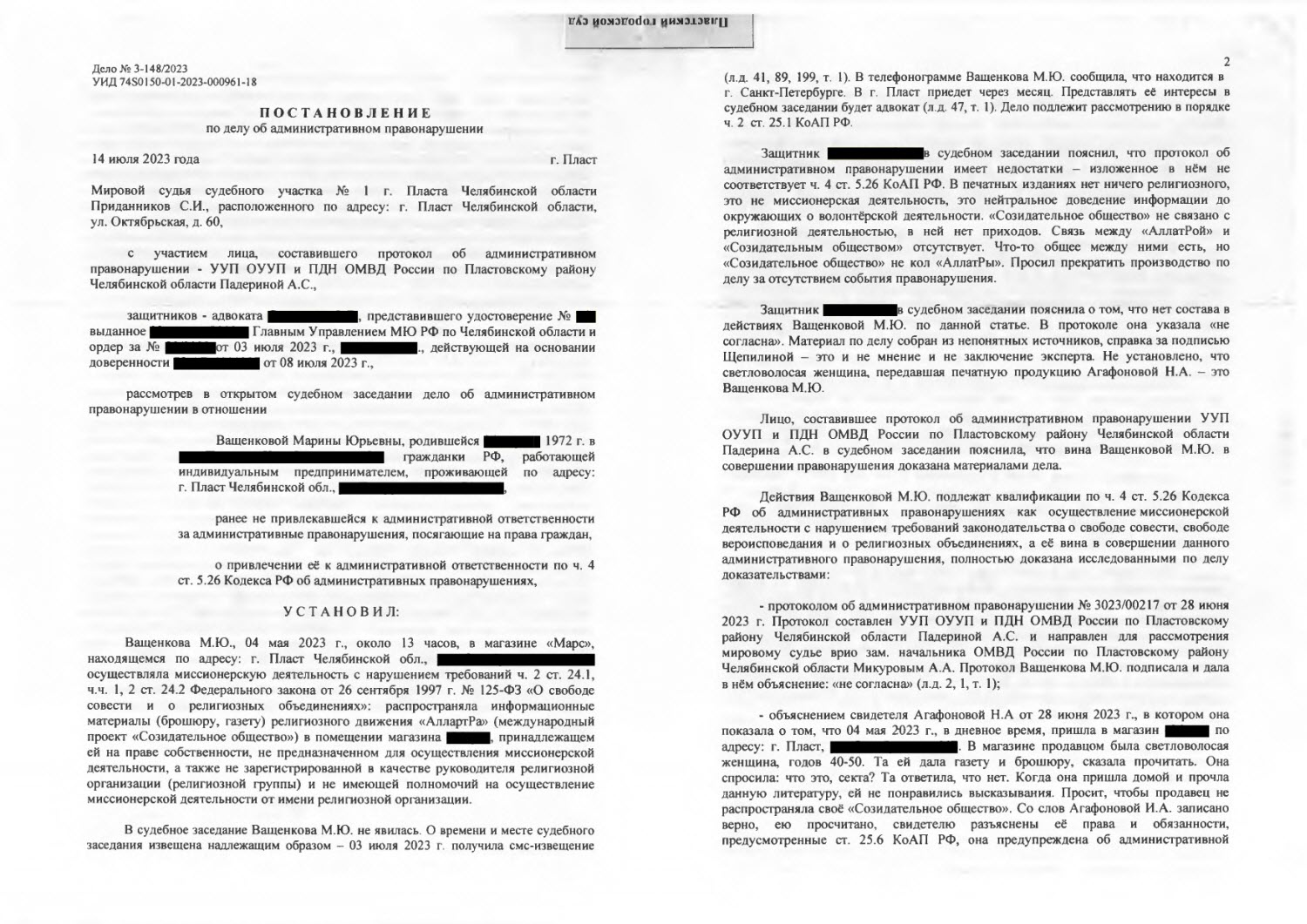
Photo 1: Court ruling on the administrative offense case, dated July 14, 2023, against M. Vashchenkova
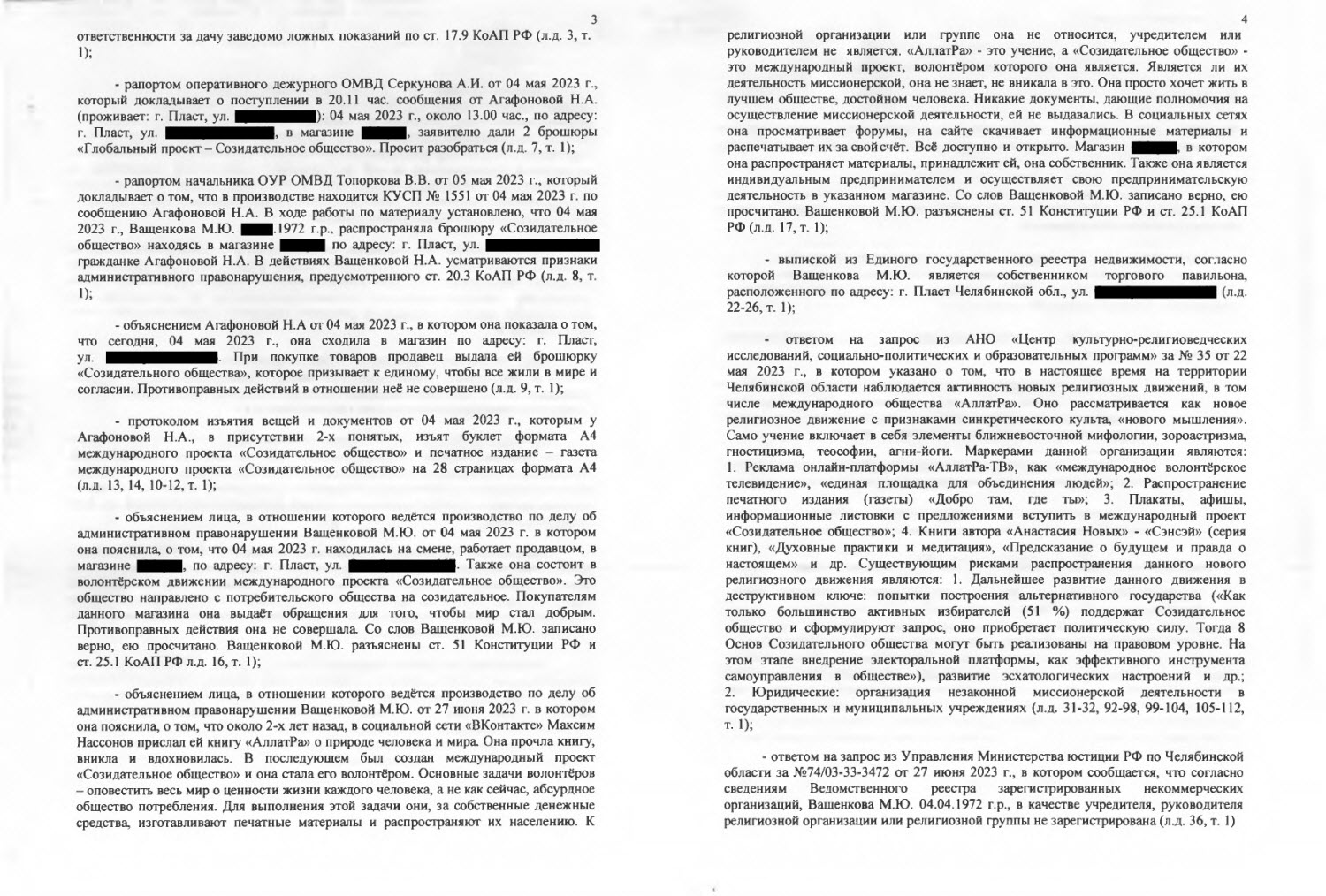
Photo 2: Court ruling on the administrative offense case, dated July 14, 2023, against M. Vashchenkova
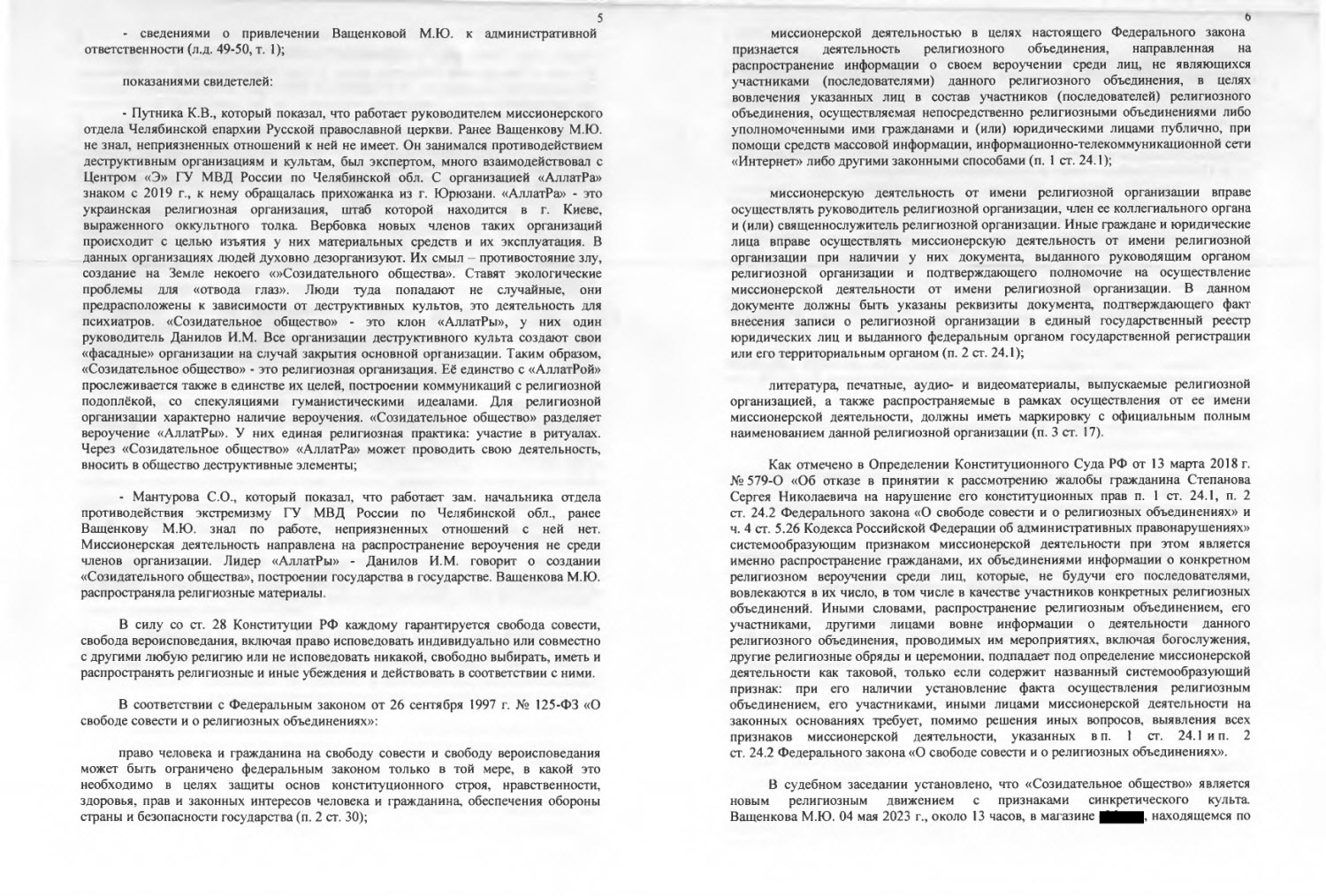
Photo 3: Court ruling on the administrative offense case, dated July 14, 2023, against M. Vashchenkova
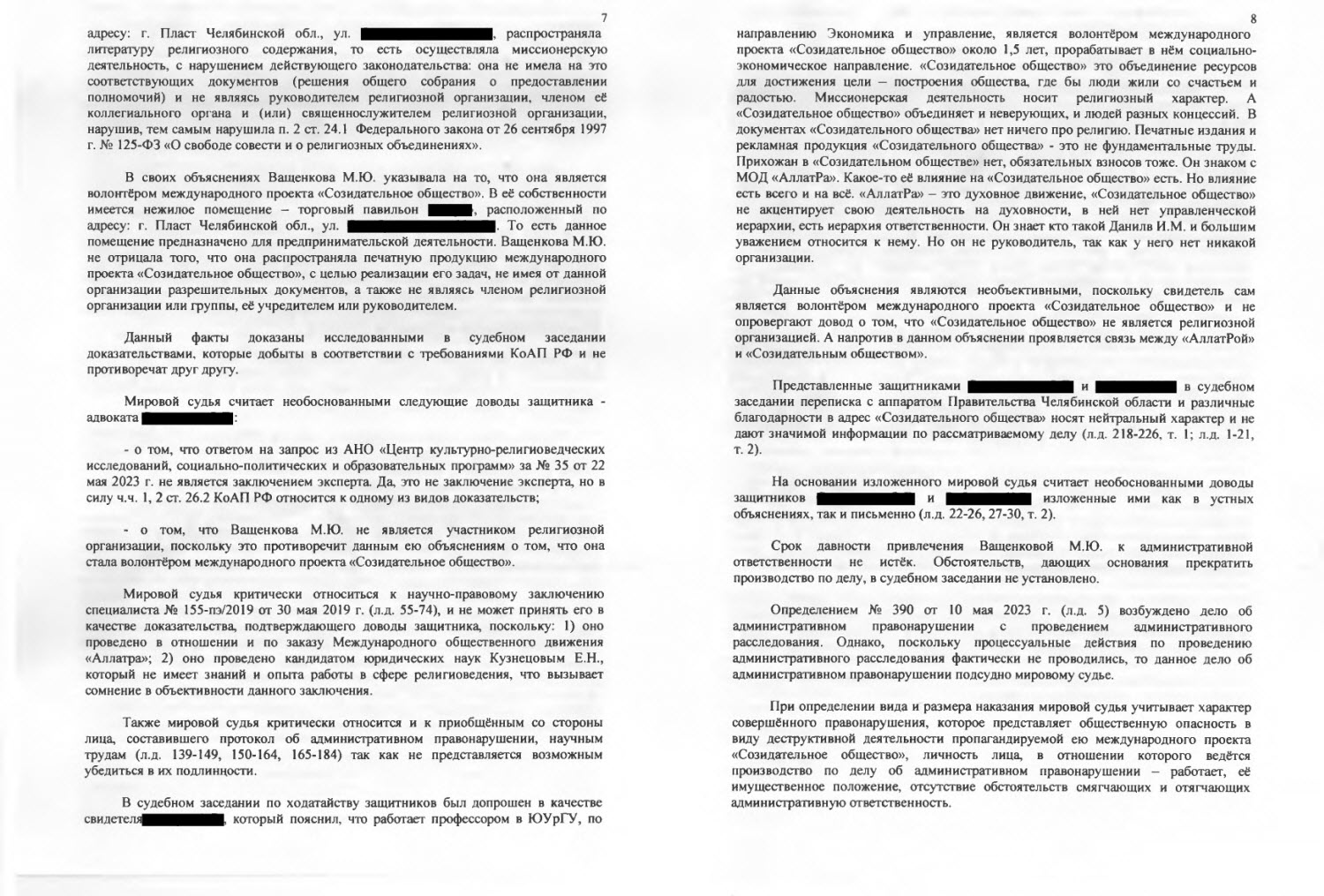
Photo 4: Court ruling on the administrative offense case, dated July 14, 2023, against M. Vashchenkova
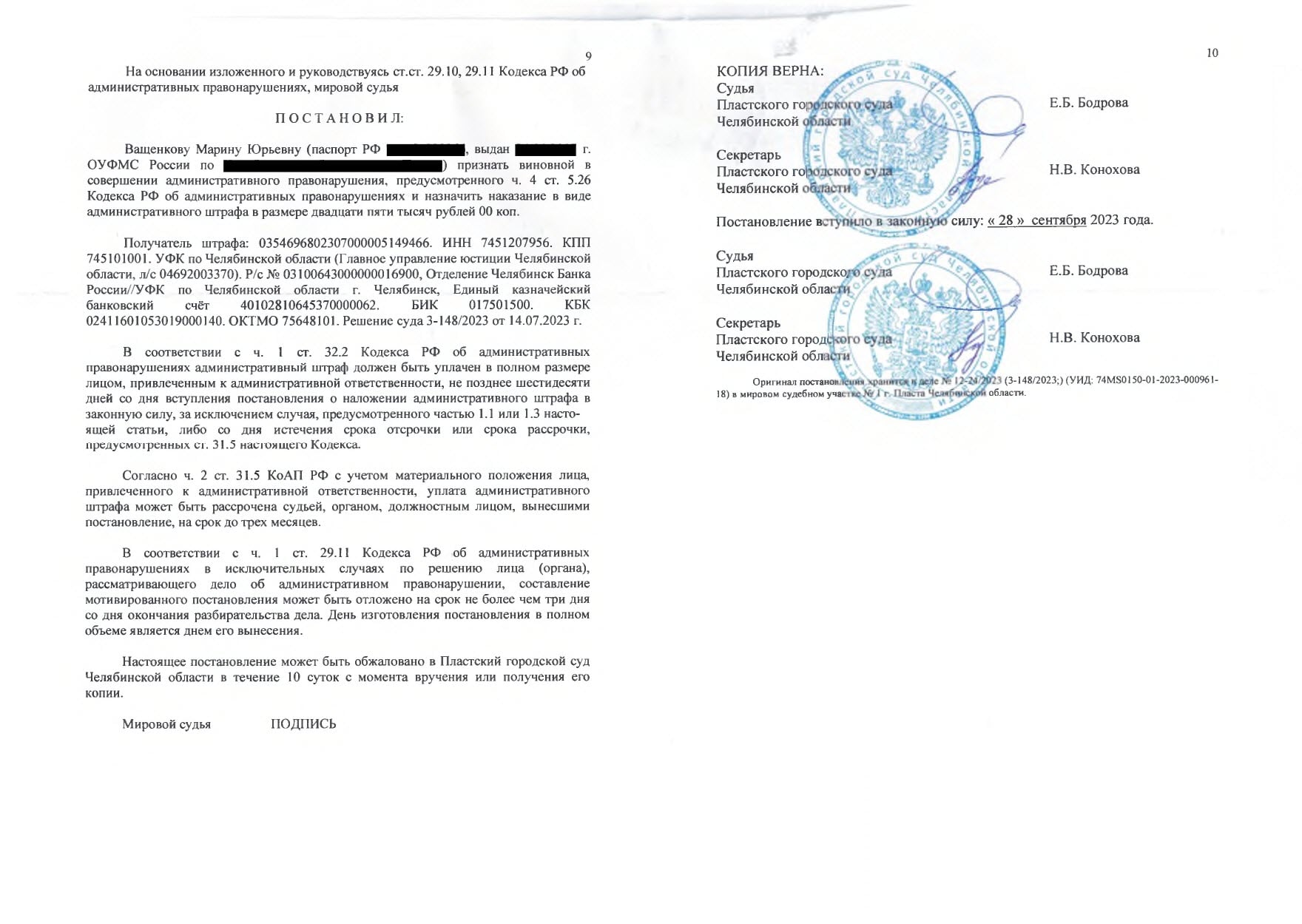
Photo 5: Court ruling on the administrative offense case, dated July 14, 2023, against M. Vashchenkova
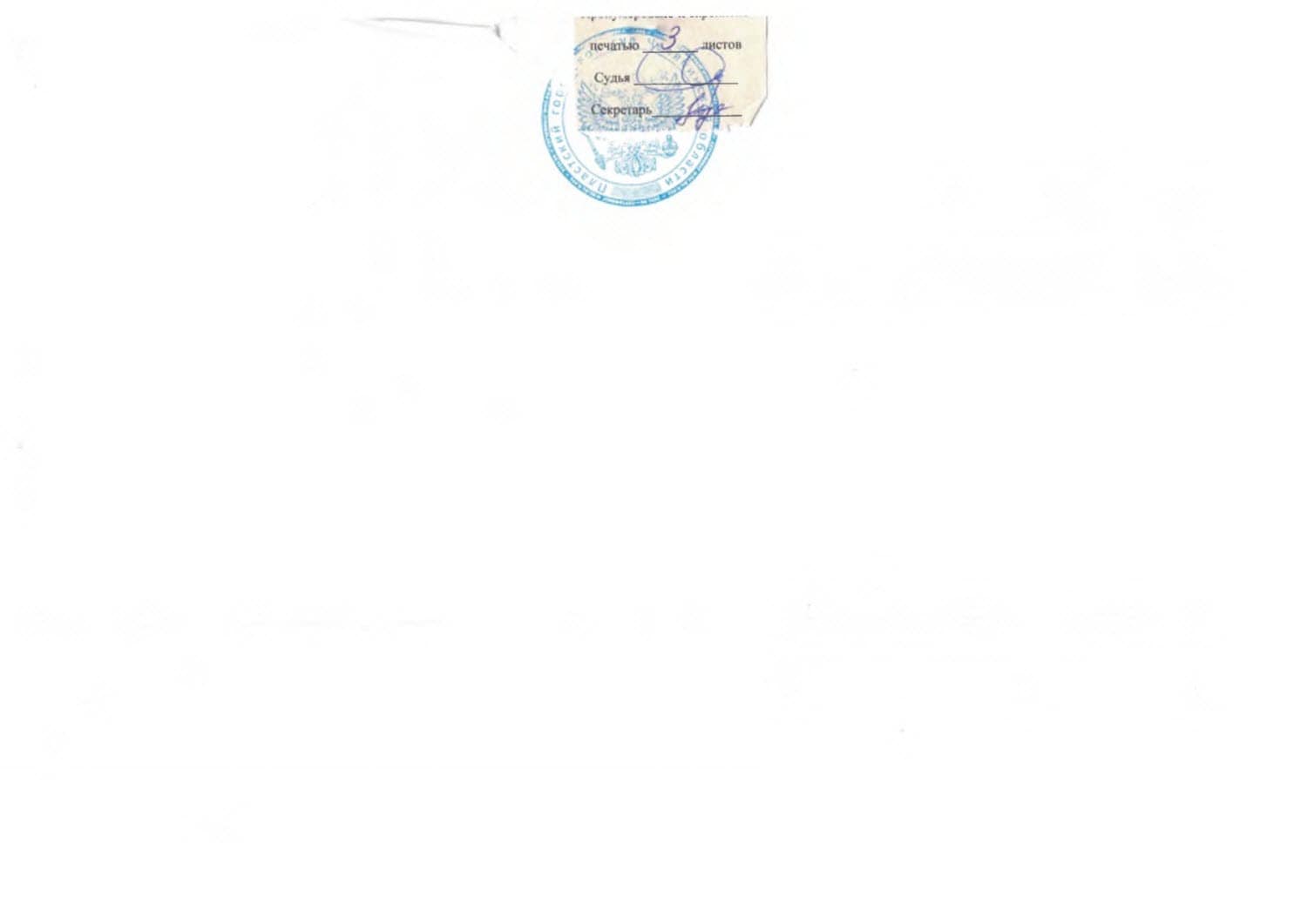
Photo 6: Court ruling on the administrative offense case, dated July 14, 2023, against M. Vashchenkova
HOWEVER, the above ruling is unlawful, unfounded, and violates the constitutional rights of M. Vashchenkova for the following reasons. In holding Vashchenkova administratively liable under the cited article, the justice of the peace based his decision on the allegation outlined in administrative offense report No. 3023/000217, dated June 28, 2023, that she was ALLEGEDLY engaged in missionary activity in violation of laws on freedom of conscience, freedom of religion, and religious associations.
According to paragraph 1, Article 24.1 of Federal Law No. 125-FZ of September 26, 1997 “On Freedom of Conscience and on Religious Associations,” missionary activity is defined as activity carried out by a religious association and aimed at disseminating information about its religious doctrine among persons who are not participants (followers) of that religious association, for the purpose of involving such persons in the religious association of participants (followers). Such activity may be carried out by religious associations themselves or by individuals and/or legal entities authorized by such associations, publicly through mass media, the information and telecommunications network Internet, or by other lawful means.
Paragraph 1, Article 6 of the same law defines a religious association in the Russian Federation as a voluntary union of Russian citizens or other persons lawfully and permanently residing in the country, which is established for jointly professing and spreading faith and possesses characteristics consistent with that purpose, including:
- a religious doctrine;
- conducting worship services and other religious rites and ceremonies;
- teaching religion and providing religious instruction to its followers.
Paragraph 2, Article 6 of the Federal Law No. 125-FZ of September 26, 1997 “On Freedom of Conscience and on Religious Associations” states that religious associations may take the form of either religious groups or religious organizations.
It is important to emphasize that neither ALLATRA International Public Movement nor its partner project Creative Society are religious organizations or groups. They do NOT promote any religious doctrine, and their activities are NOT aimed at involving individuals in any religious association. ALLATRA IPM is not a religious organization either in form (its legal status is that of a public movement) or in purpose (its goals and objectives, as defined in its Charter, differ fundamentally from those of a religious association).
Specifically, ALLATRA IPM Charter states:
- goals and objectives: formation of qualitatively new relations between peoples, based on kindness, selfless mutual assistance, and creative interaction among people all over the globe, regardless of their place of residence, social, national, political, or religious affiliation (Clause 2.2.1 of ALLATRA IPM Charter);
- restoration of justice, order, and wellbeing in all spheres of human activity (Clause 2.2.2 of ALLATRA IPM Charter);
- creation of a happy, peaceful, and free world community (Clause 2.2.3 of ALLATRA IPM Charter);
- implementation of natural human freedoms and rights (Clause 2.2.4 of ALLATRA IPM Charter);
- creation of conditions for uniting peoples of the world on a spiritual basis, on the basis of friendship and mutual assistance (Clause 2.3.1 of ALLATRA IPM Charter);
- organization of interaction between peoples of the world to improve the wellbeing of the global community (Clause 2.3.2 of ALLATRA IPM Charter);
- creation of conditions for spiritual, cultural, moral, intellectual, and creative self-improvement of every individual and the global society as a whole (Clause 2.3.4 of ALLATRA IPM Charter);
- assistance to scientific and social progress (Clause 2.3.5 of ALLATRA IPM Charter).
Creative Society is an international initiative that voluntarily brings together people from more than 180 countries. Its goal is to transition — lawfully, peacefully, and as quickly as possible — to a new, constructive societal format worldwide, where human life would be of the highest value.
Both the ALLATRA International Public Movement and the Creative Society project are built on principles of voluntary participation and openness. Their members are exclusively volunteers who adhere to a wide range of religious beliefs, including Christianity, Islam, Judaism, Hinduism, Buddhism, and others, as well as individuals who do not affiliate with any religion, including atheists. This clearly indicates the absence of any religious dominance or alignment with any specific religious tradition in the activities of the two associations, which in turn rules out the presence of any religious component in their structure or purpose.
Actions of a Group of Individuals (A.I. Serkunov, S.S. Kartsev, V.V. Toporkov, A.S. Paderina, A.A. Mikurov, A.A. Asadullin, Ye.V. Ospinnikov, S.O. Manturov, I.V. Yelesin, S.I. Pridannikov, K.V. Putnik, Ye.V. Shchetinina) Who Acted Within the Framework of a Premeditated Criminal Collusion and Under the Direction of RACIRS, to Fabricate Grounds for Recognizing ALLATRA International Public Movement and Its Partner Project Creative Society as a Single Religious Association
Statement by the Defendant M. Vashchenkova in the Administrative Offense Case No. 3-148/2023 considered by JP S. Pridannikov, Judicial District No. 1, Plast, Chelyabinsk Region:
“On May 4, 2023, I was closing my owned store ‘****,’ located in Plast, Chelyabinsk Region. It was around 8:30 p.m. A man in a police uniform approached me; he didn’t introduce himself. I asked him, ‘What do you want?’ He replied that a complaint had been called in to the police alleging that I was distributing leaflets. I told him I didn’t distribute leaflets, but there were brochures about the Creative Society project lying on the desk in my store, and that I sometimes delicately tell visitors about the project, and if they show interest, I offer them a brochure to read, which is freely available on the desk. As I explained this to the man in uniform, he was writing it down on a statement form which he then gave me to sign. I signed it. He did not provide me with a copy. I just signed it and went home.
In the morning of June 27, 2023, I received a call on my mobile phone from a man who introduced himself as police chief Asadullin. He asked me to visit him that afternoon for a conversation at the Plast District Department of Internal Affairs. Suspecting nothing, I came there, assuming he needed clarification about something. But he took advantage of my lack of legal knowledge and didn’t explain my rights to me. We spoke for over an hour about the Creative Society. He asked me about ALLATRA. I told him I had taken a passing interest in ALLATRA, but explained that ALLATRA and the Creative Society project are not connected. The Creative Society project is simply an idea of ordinary people who want to make life better. However, not everything I said was reflected in the explanation Asadullin wrote down. I didn’t know he was drafting an official document. He was typing my answers into his computer. There were a lot of questions, but when he printed the document and asked me to sign it, I noticed that many of my responses had been taken out of context: there was no full account of his questions and my answers. He told me I had to sign the document he had prepared. So I did. Only afterwards did he inform me that my statement might be submitted to the court. I said, ‘How come? Are you serious? How is that even possible? What did I violate?’
The next day, the same police chief Asadullin called again and asked me to come to his office again. I told him, ‘I’m at work, I cannot come.’ He replied, ‘Fine, we’ll come to your workplace.’ I agreed. Then chief Asadullin and police officer Angelina Paderina came to my store and brought a protocol of administrative offense. I started reading the contents and told them, ‘You’re violating my constitutional right to distribute any information through lawful means.’ After that, the conversation from these officers became very harsh and rude towards me. When I read what was written in the record, I was outraged. Ultimately, I stated that I disagreed, that I did not consider myself an offender, and I refused to sign the record.
Additionally, I’d like to report that I learned that N. Agafonova complained about me only after the case had already been submitted to the court. We live in a very small town, and we all know each other. I know all my customers. But on May 4, 2023, citizen N. Agafonova did not visit my store.”
Violation by JP S. Pridannikov of the Mandatory Procedure for Preparing Hearings in the Administrative Offense Case
Article 24.1 of CAO RF stipulates that the objectives of proceedings in administrative offense cases are comprehensive, complete, objective, and timely clarification of the circumstances of each case, its resolution in accordance with the law, enforcement of the issued ruling, as well as identification of causes and conditions that contributed to the commission of administrative offenses. Pursuant to Part 1 of Article 1.6 of CAO RF, ensuring legality in the application of administrative coercive measures requires not only the existence of legal grounds for imposing administrative penalties, but also adherence to the legally prescribed procedure for holding an individual administratively liable.
In order to fulfill the objectives set forth in Article 24.1 of CAO RF, when preparing an administrative offense case hearings, a judge must undertake procedural actions listed in Article 29.1 of CAO RF (Section 2 of the Resolution No. 5 of the Plenum of the Russian Federation Supreme Court, dated March 24, 2005, “About some questions arising at courts in case of application of the Russian Federation Code of Administrative Offenses”). According to paragraph 5, Part 1, Article 29.1 of CAO RF, those actions include resolving the question of whether materials available in the case are sufficient for consideration on the merits. If the materials submitted are insufficient, the judge must issue a ruling under Part 1 of Article 29.4 of CAO RF, requesting the necessary additional materials.
In preparing this particular case for consideration, justice of the peace S. Pridannikov violated subparagraphs 3, 4, and 5 of Article 29.1 of CAO RF which require the judge to determine whether the administrative offense protocol and other procedural documents have been correctly compiled in accordance with CAO RF, whether other documents are properly executed, whether they are sufficient to consider the case on its merits, and whether there are any circumstances precluding the proceedings.
Despite identifying numerous violations committed by officials of the Russian Ministry of Internal Affairs in Chelyabinsk Region when compiling the inspection materials and carrying out administrative proceedings against M. Vashchenkova, JP Pridannikov failed to perform the mandatory procedural action of returning the case materials to the Ministry of Internal Affairs Department for Chelyabinsk Region for correction of deficiencies. By failing to fulfill this obligation, JP Pridannikov himself violated provisions of CAO RF. Furthermore, in breach of CAO RF, JP Pridannikov took it upon himself to rectify the violations committed by officers of the Ministry of Internal Affairs in Chelyabinsk Region, thereby exceeding his official authority, which represents an act that constitutes grounds for criminal liability under Article 286 of the Criminal Code of the Russian Federation (hereinafter referred to as CC RF). This unlawful conduct by JP Pridannikov led to him issuing a deliberately unjust court ruling against M. Vashchenkova, which in turn entails criminal liability for him under Article 305 of CC RF.
Lack of Proper Grounds for Initiating Proceedings and Unverified Identity of the Alleged Victim
As follows from the materials in the administrative offense case No. 3-148/2023, on May 4, 2023, at 8:11 p.m., the Plast District Department of Internal Affairs, Chelyabinsk Region, received a report from Nina Alexandrovna Agafonova stating that on May 4, 2023, around 1:00 p.m., at the store “****” located at [redacted address], the complainant had been given two brochures titled “Global Project — Creative Society.” The police unit arrived at the scene at 8:25 p.m. on May 4, 2023 (Report by the duty officer of the duty unit of the Ministry of Internal Affairs Department for Plast District in Chelyabinsk Region, junior police lieutenant A.I. Serkunov, dated May 4, 2023) [Vol. 1, p. 7, Photo 7].
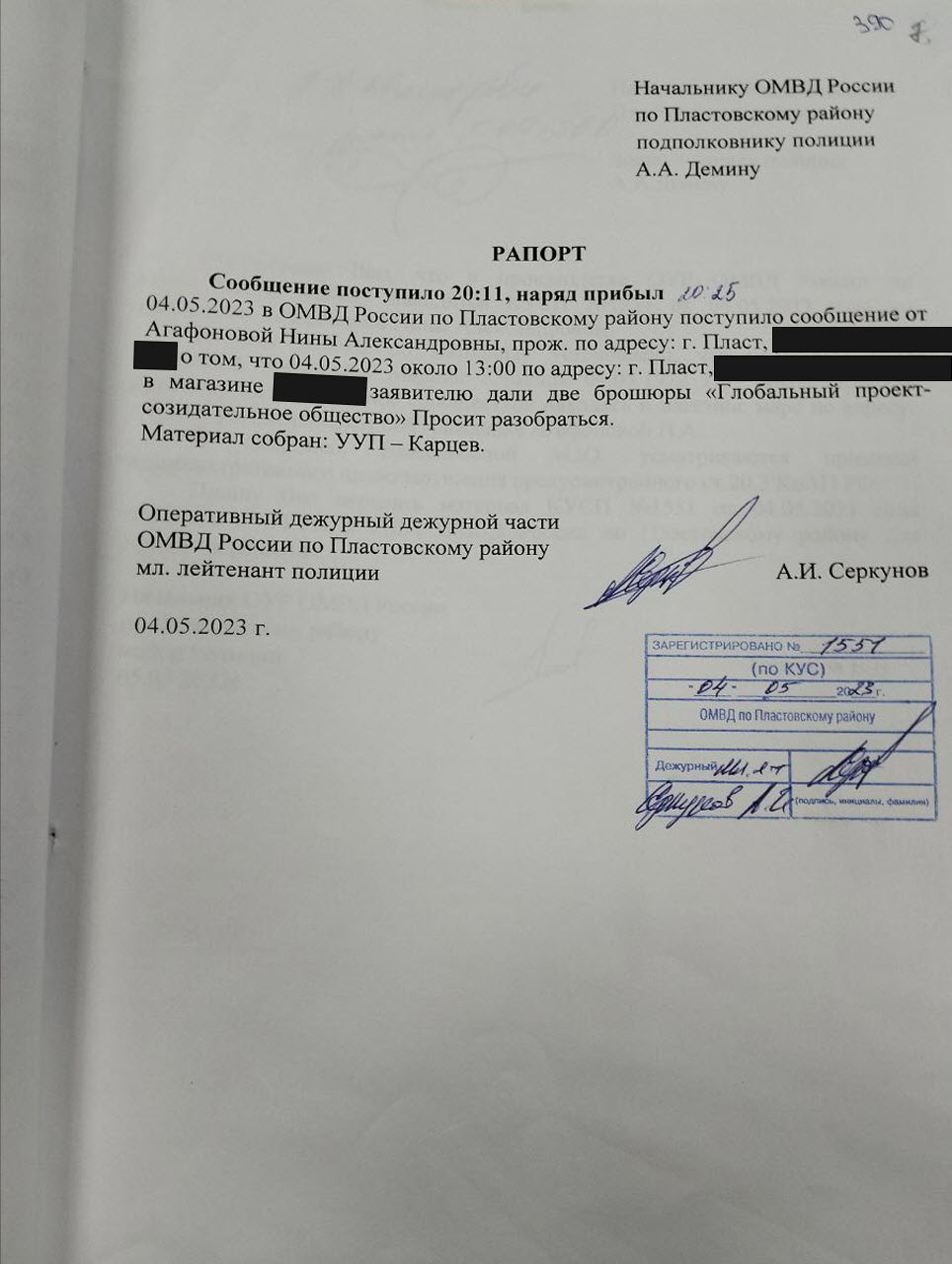
Photo 7: Report by the duty officer of the duty unit of the Ministry of Internal Affairs Department for Plast District in Chelyabinsk Region, junior police lieutenant A.I. Serkunov, dated May 4, 2023
This report is absurd. What exactly is Ms. Agafonova asking to investigate? Was she unsure of how to read the text: left to right or right to left? Was she unable to read it at all? Did the police fail to clarify the purpose of her complaint, or perhaps no such complaint ever occurred?
Thus, neither this report nor any other materials in the administrative case indicate how exactly the message from N.A. Agafonova was received, nor do they substantiate that M. Vashchenkova was disseminating information specifically about the doctrine of any religious association, or how that information was allegedly disseminated. Therefore, the contents of the complaint do not contain any ground for initiating an administrative case under Article 28.1 of CAO RF.
Thus, the following deficiencies are evident in the report by the duty officer A.I. Serkunov, dated May 4, 2023 [Vol. 1, p. 7, Photo 7]:
- It does not specify how the message from N.A. Agafonova was submitted (by phone, in person, or by written statement).
- It does not cite any characteristics of an administrative offense or any facts suggesting one occurred.
- The report notes that the message was received at 8:11 p.m. and that the unit arrived at 8:25 p.m. Upon receiving the message, the duty officer dispatched a unit to investigate the complaint and facts that do not indicate the occurrence of any offense. The only information recorded is that at 1:00 p.m. Agafonova received two brochures titled “Global Project — Creative Society” in the store. Nothing in this account suggests any unlawful act. Not only does the report lack any indication of an offense, but the remarkably swift response from the Plast police is also suspicious. Just 14 minutes elapsed between receiving the message and the police unit arriving at the location of the alleged offense. Apparently, in the Plast District of Chelyabinsk Region, all criminals and violators have already been apprehended, leaving the police with nothing to do but fabricate cases against completely innocent individuals.
Moreover, during proceedings in the court of first instance, the case materials did not properly confirm the existence of such an individual as Nina Alexandrovna Agafonova born in 1947: there are no passport details or any other identity documents provided. According to the Decree of the Russian Federation President, No. 232 dated March 13, 1997, “On the Primary Document Certifying the Identity of a Citizen of the Russian Federation in the Territory of the Russian Federation,” the primary identity document is the passport. Hence, law enforcement authorities in the city of Plast, Chelyabinsk Region, failed to establish the identity of N.A. Agafonova, the alleged victim in the case, which is an obvious procedural violation on the part of the police. Nevertheless, JP S. Pridannikov failed to acknowledge this violation.
Violations During the Seizure of Printed Materials and Legal Inadmissibility of the Evidence Obtained
The protocols and statements compiled during the proceedings were drawn up with gross violations of the provisions of CAO RF and were thus unreasonably accepted as evidence of M. Vashchenkova’s guilt by the justice of the peace.
In particular, on May 4, 2023, without specifying the time, a protocol of seizure of items and documents was drawn up by junior police lieutenant S.S. Kartsev, precinct officer of the Department for Juvenile Affairs and Preventive Work, Plast District Department of Internal Affairs, Chelyabinsk Region. The protocol alleges participation of Nina Alexandrovna Agafonova born on **.**. 1947, but was executed in the absence of M. Vashchenkova, in office No. 5 of the Plast District Department of Internal Affairs at 58 Oktyabrskaya St., Plast [Vol. 1, p. 13, Photo 8].
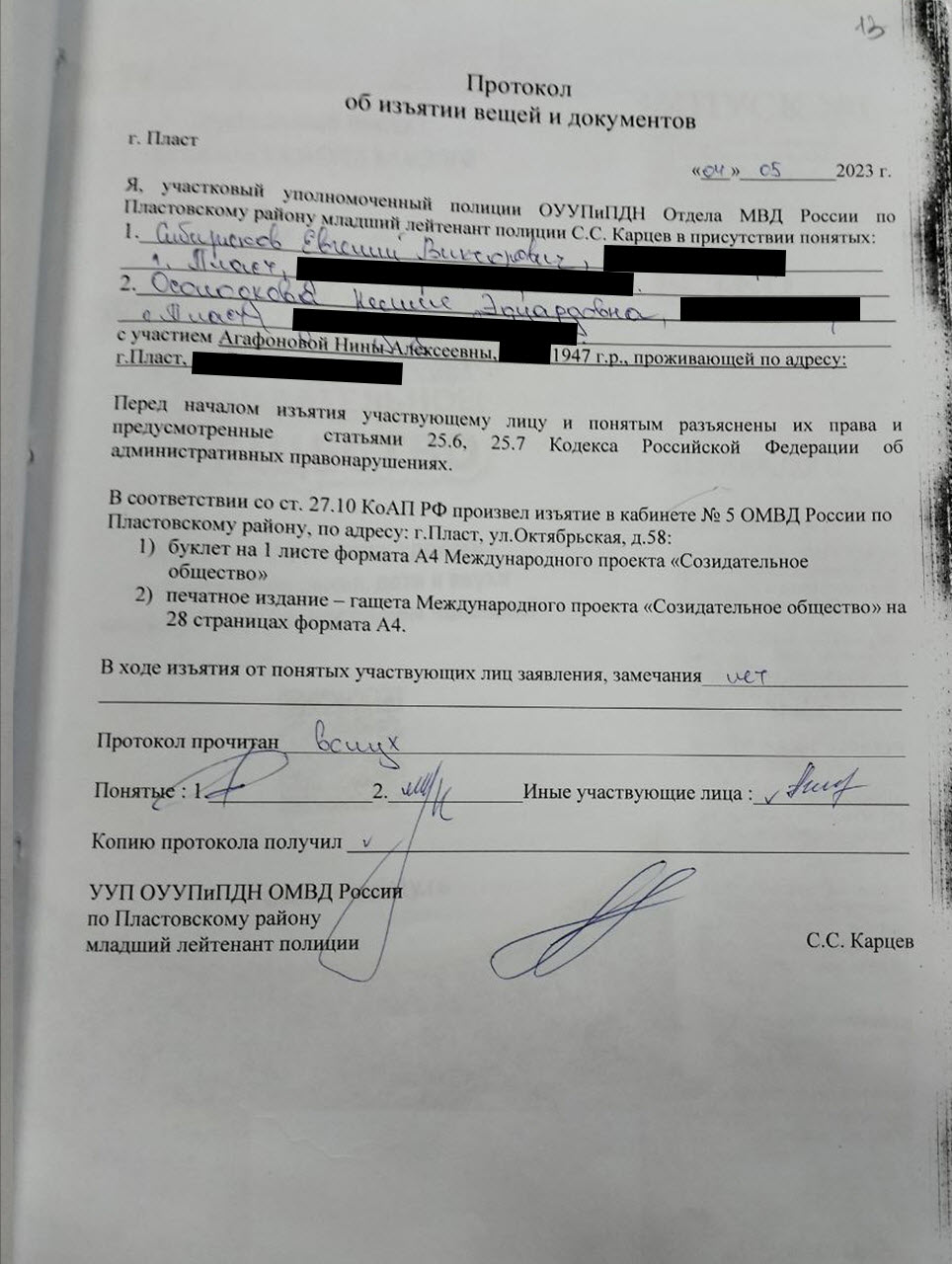
Photo 8: Protocol of seizure of items and documents, dated May 4, 2023, drawn up by junior police lieutenant S.S. Kartsev, precinct officer of the Department for Juvenile Affairs and Preventive Work, Plast District Department of Internal Affairs, Chelyabinsk Region
This seizure protocol violates subparagraphs 6–9 of Article 27.10 of CAO RF, as it lacks:
- The identity of the person from whom the items and documents were seized (it is unclear whether the junior lieutenant seized the items from himself, from witnesses, or simply found them on the floor);
- Details of identity documents of N.A. Agafonova and the witnesses;
- Details of the seized documents and other identifying characteristics of the items;
- A note on the use of photography as a means of documentation (all seized documents should have been photographed page-by-page), even though the protocol includes photographs of the seized items (violation of paragraph 7 of Article 27.10 of CAO RF;
- Information on packaging and sealing of documents at the place of seizure.
The protocol indicates that the seizure occurred in the office of the Plast District Department of Internal Affairs, although such a seizure could have only taken place either at M. Vashchenkova’s store or during an examination of N.A. Agafonova’s belongings. However, the protocol contains no mention of an examination of Agafonova’s belongings, again in violation of Article 27.10 of CAO RF.
The seizure could not have occurred earlier than 9.00 p.m., since Kartsev arrived at the scene at 8:25 p.m. and was still recording Vashchenkova’s statement, which likely took at least half an hour. This gives grounds to believe that N.A. Agafonova was not actually present during the seizure, given her age of 76 years old (as inferred from the birth year provided, though neither identity document nor she personally were present) and the fact that she never appeared in court, allegedly due to poor health.
Given that the seizure protocol fails to specify the individual from whom the items and documents were confiscated (whether from the witnesses or another person present during the procedural action), and that this person did not sign the protocol and there is no confirmation that they or their legal representative were provided a copy of it (the line “I received a copy of the protocol” contains no signature), the officer merely documented the seizure not from a specific individual, but from the location — the office — into which, apparently, he had placed the materials himself.
The personal details of N.A. Agafonova were typed into the protocol, while the data for the two attesting witnesses were handwritten in full. This raises grounds to believe the witnesses were not present during the seizure (in violation of Article 27.10 of CAO RF).
Thus, the protocol does not certify the seizure of materials from either M.Yu. Vashchenkova or N.A. Agafonova. The materials attached to the case cannot be regarded as physical evidence because their origin is unclear. The seizure protocol was drawn up with gross violations of CAO RF and cannot be considered admissible evidence in the case.
It is also noteworthy that the protocol lists as confiscated: a one-page A4 brochure and a printed publication — “gaSHeta” (not gaZeta) of the Creative Society international project, consisting of 28 A4 pages [Vol. 1, p. 13, Photo 8]. In cases of typographical or clerical errors, a specific correction procedure must be followed: a note must be made in the same procedural document about the correction and signed by the official, which was not done in this case.
These violations indicate a potential offense under Article 303 of CC RF (Falsification of Evidence and Results of Investigative Activity) in the actions of precinct officer S.S. Kartsev.
However, the printed materials described in the seizure protocol were not presented to the court and were therefore not examined as direct evidence of the alleged offense. As a result, no evaluation of this evidence was provided in the ruling issued on July 14, 2023, by Sergey Pridannikov, justice of the peace of Judicial District No. 1 in Plast, Chelyabinsk Region, who found M.Yu. Vashchenkova administratively liable under Part 4 of Article 5.26 of CAO RF.
The case materials include a package containing printed materials, including the Creative Society brochure [Vol. 1, p. 14, Photos 9-10].
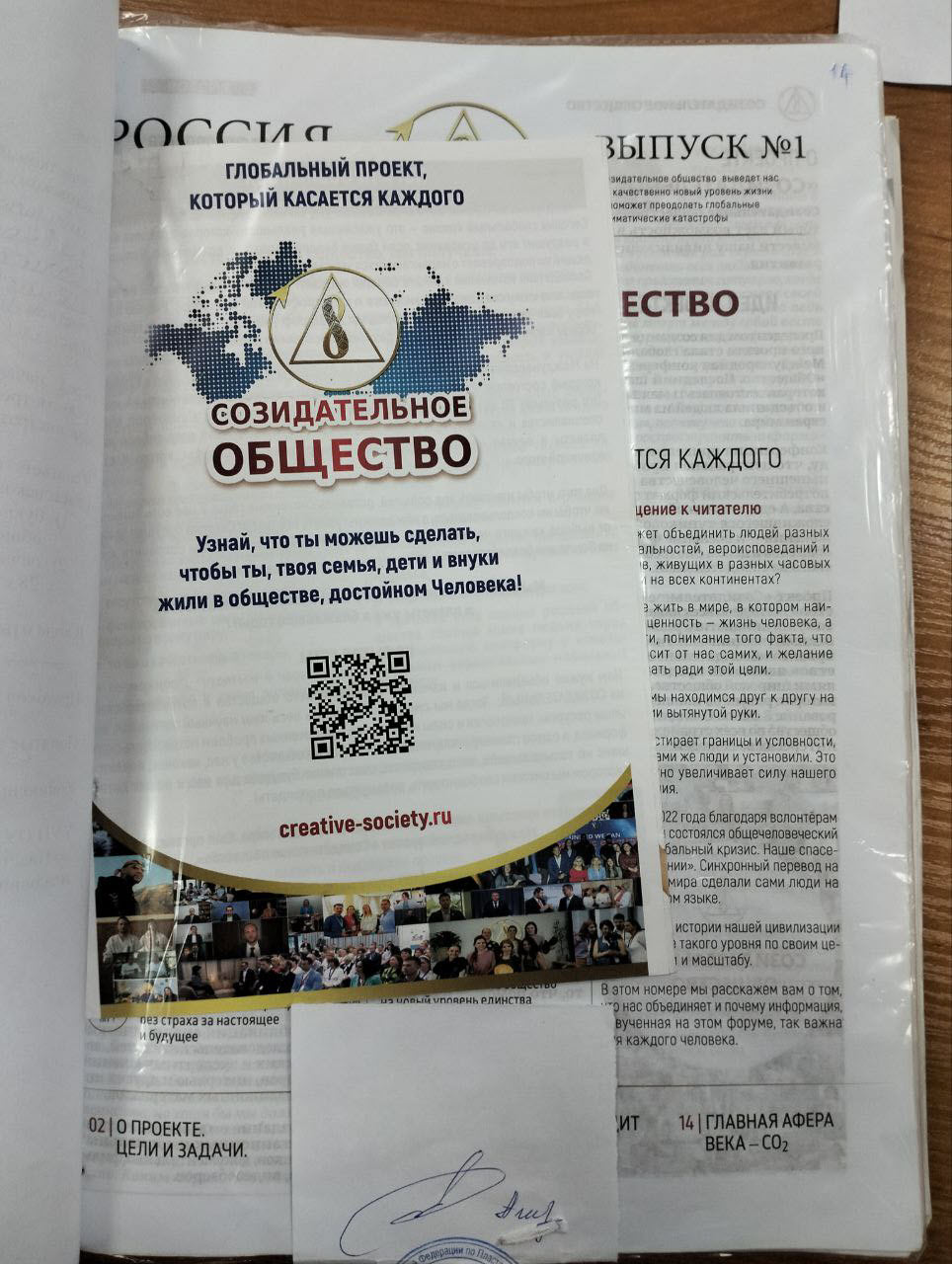
Photo 9: Creative Society brochure, part 1
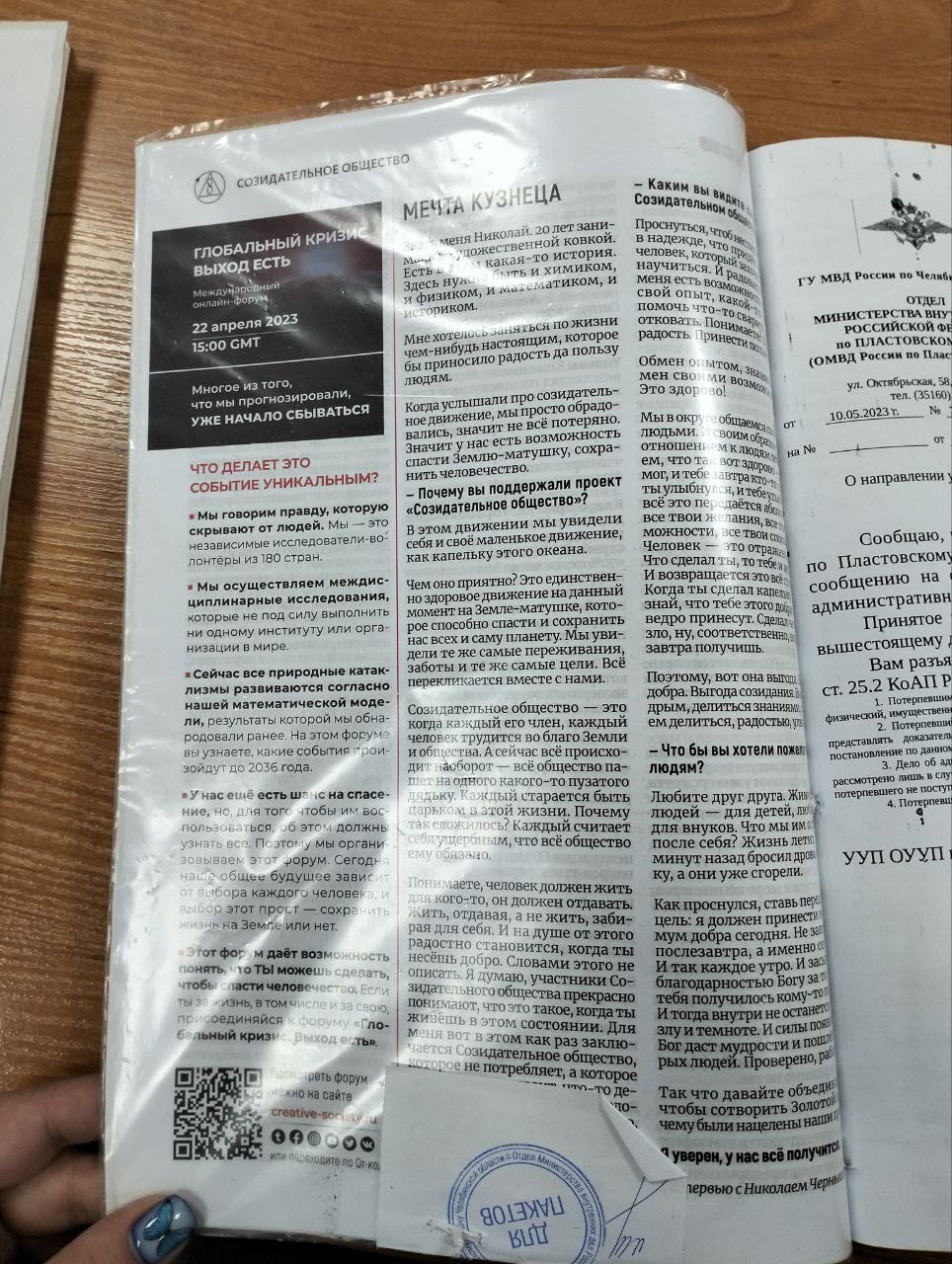
Photo 10: Creative Society brochure, part 2
However, during the court proceedings in the first instance, these printed materials were not examined by JP S. Pridannikov. The package containing the alleged items of offense was not even opened by the judge for examination. Consequently, the legally required assessment of the admissibility, relevance, and credibility of this evidence was not conducted by the judge, and no evaluation of such evidence was given.
Moreover, in N.A. Agafonova’s initial statement dated May 4, 2023, there is no mention of her receiving any newspaper (gaSHeta) or leaflet from M.Yu. Vashchenkova. She only refers to a brochure [Vol. 1, p. 9, Photos 11-12].
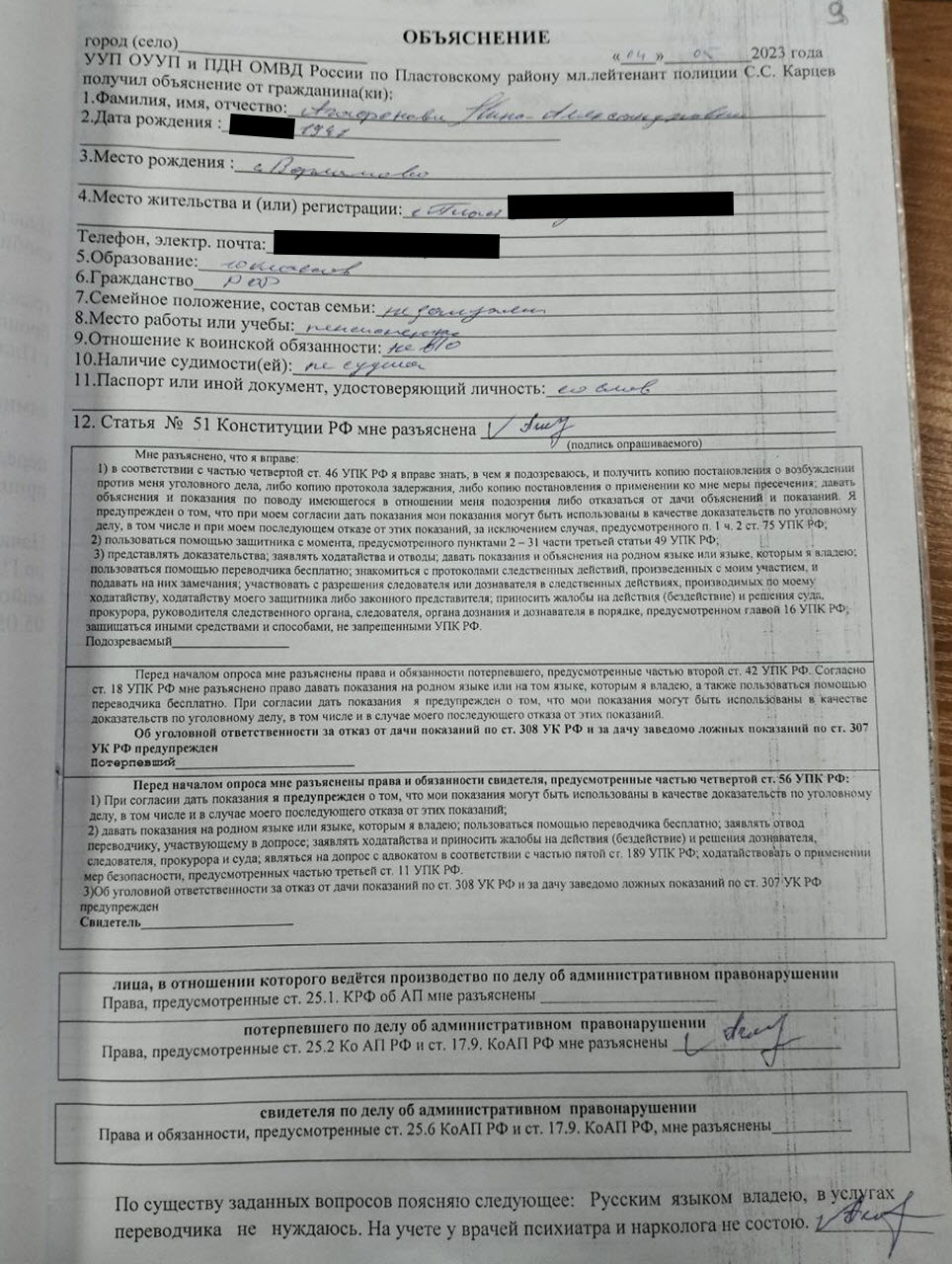
Photo 11: Statement by N.A. Agafonova, part 1
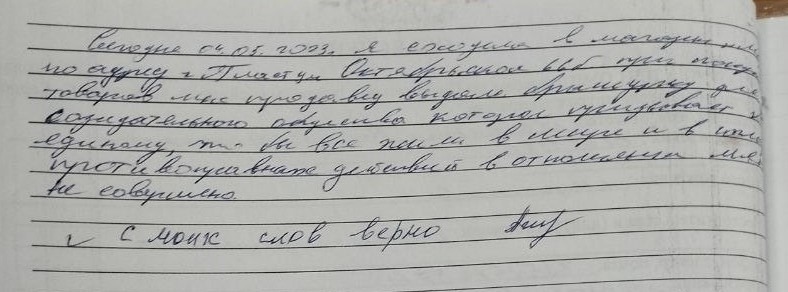
Photo 12: Statement by N.A. Agafonova, part 2
The above indicates that the means of committing the administrative offense were not established in the case materials.
This raises a question: what is the connection between Vashchenkova → printed materials → Agafonova? NO such connection was established.
Thus, the factual circumstances and evidence that would confirm the occurrence of an offense are absent in the case files.
Introduction of New Information in the Report, Not Supported by Previously Collected Materials
In the report on the transfer of materials to the Department for Juvenile Affairs and Preventive Work of the Plast District Department of Internal Affairs, Chelyabinsk Region, dated May 5, 2023, authored by V.V. Toporkov, head of the Criminal Investigation Division of the Plast District Department of Internal Affairs [Vol. 1, p. 8, Photo 13], it is stated that M.Yu. Vashchenkova’s actions show signs of an administrative offense under Article 20.3 of CAO RF. This article covers propaganda or public display of Nazi paraphernalia or symbols, or those of extremist organizations, or other paraphernalia or symbols whose propaganda or public display is prohibited by federal law. However, in the original documents — the report dated May 4, 2023, and the statements by M.Yu. Vashchenkova and N.A. Agafonova, dated May 4, 2023 — there is no mention of such actions by Vashchenkova whatsoever.
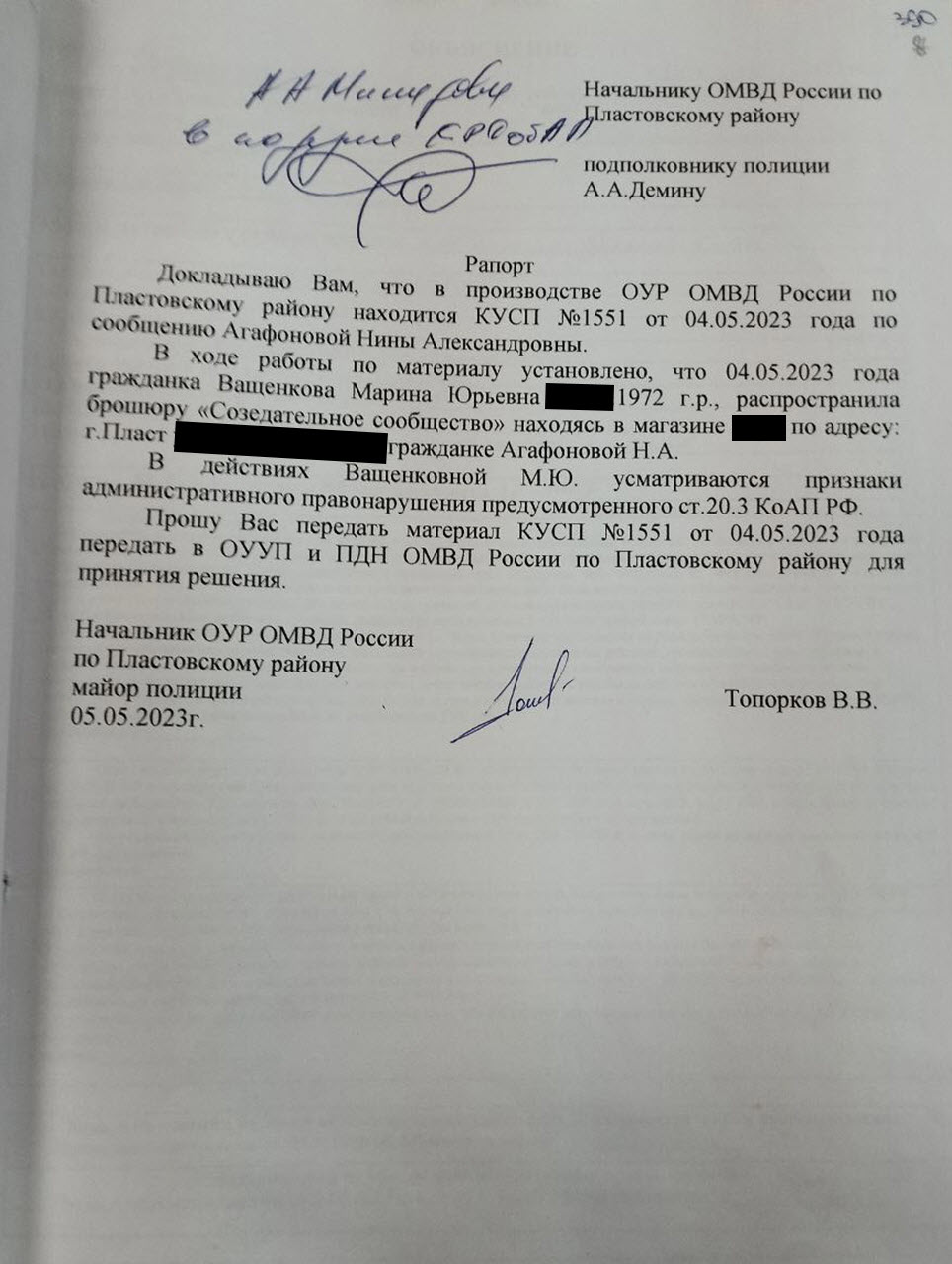
Photo 13: Report on the transfer of materials to the Department for Juvenile Affairs and Preventive Work of the Plast District Department of Internal Affairs, Chelyabinsk Region, dated May 5, 2023, authored by V.V. Toporkov, head of the Criminal Investigation Division of the Plast District Department of Internal Affairs
Absence of Evidence of an Offense in N.A. Agafonova’s Statements
The statements made by N.A. Agafonova, first as a victim and later as a witness on May 4 and June 28, 2023, respectively, were also recorded by the police with gross procedural violations. As such, they carry no legal weight and cannot serve as evidence in the case under Part 3 of Article 26.2 of CAO RF. For instance, Agafonova’s statement as a victim on May 4, 2023, allegedly recorded from her words, has not been signed by the official who recorded it, contains no indication of the time or place it was made, nor does it include passport or any other ID information certifying N.A. Agafonova’s identity [Vol. 1, p. 9, Photos 11-12].
In that statement, Agafonova declared: “Today, on May 4, 2023, I went to the store at the address: *********, Plast City. When I was buying goods, the saleswoman gave me a Creative Society brochure that called for unity and peaceful coexistence. No unlawful actions were committed against me.” It is particularly important to note that in this statement, Agafonova makes no reference to any offense being committed, nor does she perceive the content of the brochure as religious or associated with any belief system [Vol. 1, p. 9, reverse side, Photos 11-12].
Furthermore, her statement from May 4, 2023 [Vol. 1, p. 9, Photos 11-12] does not specify the LOCATION where it was made (which city or village, whether in a house, in the store, or at the police station, or perhaps even on another planet?). Moreover, in both Agafonova’s statements — from May 4, 2023 [Vol. 1, pp. 9, Photos 11-12] and June 28, 2023 [Vol. 1, pp. 16, Photos 21-22] — it is totally unclear who exactly was questioned. In particular, the first name and patronymic are illegible, and there is no signature of the official who conducted the interrogation.
Unlawful Initiation of the Case and the Fabricated Administrative Investigation Process
Nevertheless, on May 10, 2023, junior police lieutenant A.S. Paderina, district officer of the Department for Juvenile Affairs and Preventive Work of the Plast District Department of Internal Affairs, Chelyabinsk Region, issued Decision No. 390 to initiate an administrative offense case [Volume 1, p. 5, Photo 14] under Part 4, Article 5.26 of CAO RF, “Implementation of missionary activities with violation of requirements of the legislation on liberty of conscience, religious liberty and about religious associations,” and to begin an administrative investigation to establish the circumstances and collect materials related to the alleged administrative offense, which was done with the following violations:
• There was no sufficient data to initiate an administrative offense case against M.Yu. Vashchenkova that would indicate the occurrence of an offense, which constitutes a violation of Part 3, Article 28.1 of CAO RF. When issuing Decision No. 390 [Volume 1, p. 5, Photo 14], the statement made by N.A. Agafonova on May 4, 2023, wasn’t taken into account, where she wrote, “No unlawful actions were committed against me.” Given the absence of an offense, there were no legal grounds for initiating proceedings in the case (Article 24.5 of CAO RF was violated). In other words, there were circumstances that precluded proceedings in the administrative offense case, i.e. allowed it to be terminated.
• Under paragraph 4, Part 4 of Article 28.1 of CAO RF, the issuance of a decision to initiate the case was unlawful, as there was no necessity to conduct an administrative investigation under Article 28.7 of CAO RF because offenses under Part 4 of Article 5.26 of CAO RF do not provide for administrative investigation (according to Part 1 of Article 28.7 of CAO RF). A case under Part 4 of Article 5.26 of CAO RF, as charged against M.Yu. Vashchenkova, is considered initiated at the moment the administrative offense protocol is drawn up. In other words, the decision to initiate the case against M.Yu. Vashchenkova should not have been issued at all, and no investigation should have been launched, since the offense she was charged with under Article 5.26 of CAO RF does not require investigation. Instead of a decision, only an administrative offense protocol should have been drawn up — a document which, according to CAO RF, simultaneously serves as a procedural act marking the initiation of such a case. However, in violation of CAO RF, A.S. Paderina prepared two procedural documents in relation to M.Yu. Vashchenkova: a decision to initiate the administrative case and an administrative offense protocol, while only the protocol should have been issued.
• The administrative investigation was unlawfully initiated. According to paragraph 2, subsection “a” of Section 3 of the Resolution No. 5 of the Plenum of the Russian Federation Supreme Court, dated March 24, 2005, “About some questions arising at courts in case of application of the Russian Federation Code of Administrative Offenses,” an administrative investigation is permitted only in cases involving administrative offenses in the fields of legislation listed in Part 1 of Article 28.7 of CAO RF. The case category under consideration (Article 5.26 of CAO RF, “Violation of the Laws on Freedom of Conscience and Freedom of Belief, as Well as on Religious Associations”) is not included in the specific list of administrative offenses provided by that article.
• Six days elapsed between the date the administrative offense was identified (May 4, 2023) and the date Decision No. 390 was issued (May 10, 2023), which violates Part 2 of Article 28.7 of CAO RF. According to that provision, a decision to initiate an administrative offense case and to conduct an administrative investigation must be issued by an official authorized under Article 28.3 of CAO RF to draw up an administrative offense protocol in the form of a ruling or by a prosecutor in the form of a decree, immediately after the administrative offense is identified.
• In paragraph 3 of Decision No. 390, it is stated: “A copy of the decision on the administrative offense shall be sent for review to the parties involved, with an explanation of their right to appeal against this decision. After identifying the individuals who caused the battery, a copy of the decision shall also be sent for review.” The title of the document referenced in this paragraph does not correspond with point 1 of the operative part. The descriptive part fails to specify what the violation consists in. Furthermore, the operative part of this decision provides an explanation of the right to appeal in connection with a different offense specified in Article 6.1.1 of CAO RF (battery). In other words, the author of this decision made a gross error. The case was initiated under Part 4 of Article 5.26 of CAO RF (illegal missionary activities), while the explanation of rights to the accused refers to Article 6.1.1 of CAO RF (battery), which constitutes a severe violation. This means that, in violation of Part 3, Article 28.7 of CAO RF, M.Yu. Vashchenkova was not informed of her right to appeal, rendering this piece of evidence inadmissible [Volume 1, p. 5, Photo 14]. Moreover, the document makes it impossible to determine who issued it — whether it was district police officer A.S. Paderina of the Plast District Department of Internal Affairs or the deputy chief of public order police A.A. Mikurov, or both. (If Mikurov A.A. approved this procedural document, then why is the note “Approved” missing?)
• According to Part 3.1 of Article 28.7 of CAO RF, a copy of the decision to conduct an administrative investigation must be delivered by hand with a signed acknowledgement or sent to the individual or the legal entity’s legal representative, as well as to the victim, within 24 hours. However, the case files lack any document confirming that Decision No. 390 was delivered to M.Yu. Vashchenkova within 24 hours or handed to her against signature. This violated her right to defense during the administrative proceedings and her right to appeal against the decision to initiate the case.
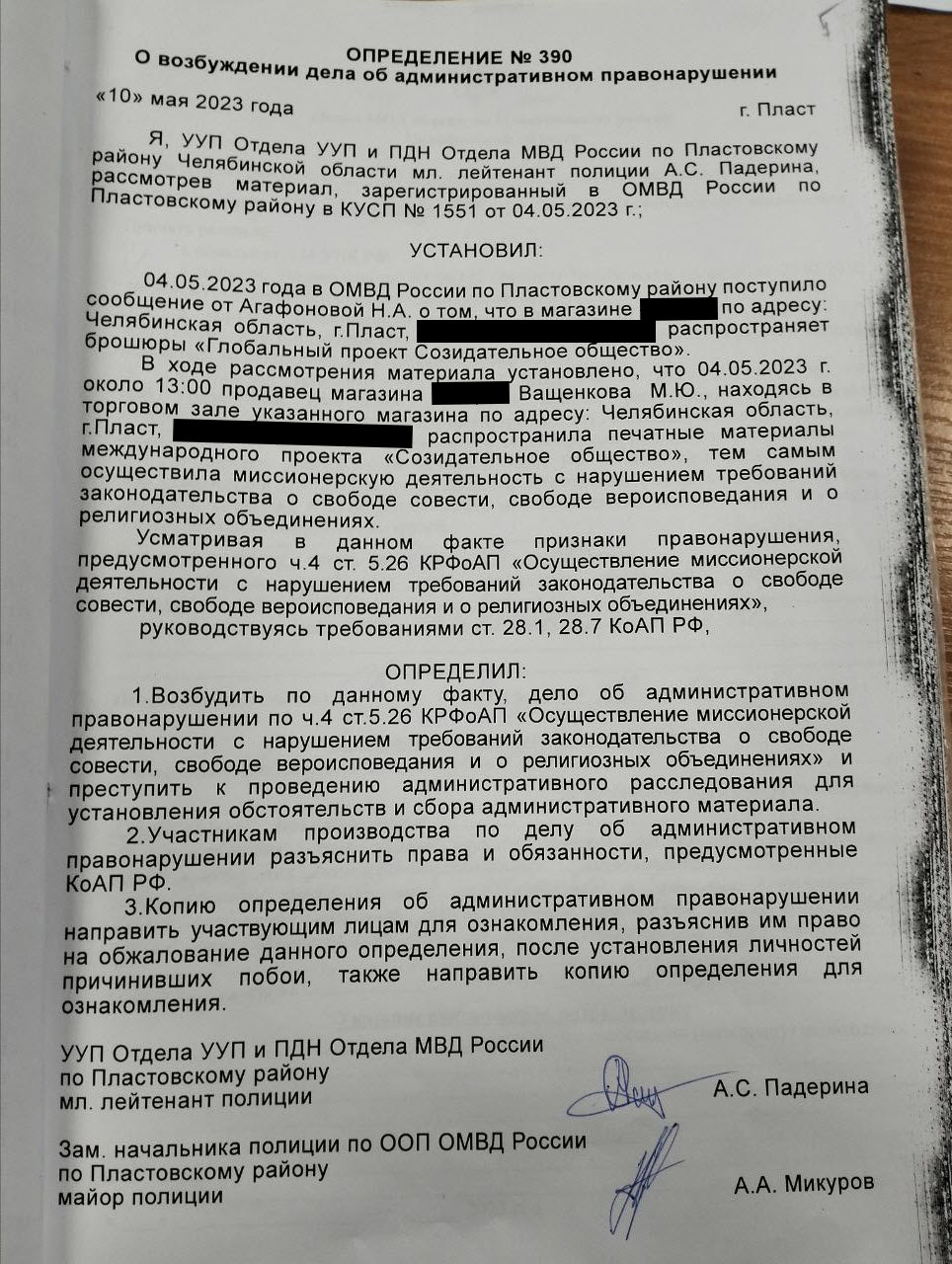
Photo 14: Decision No. 390 dated May 10, 2023, on initiating administrative proceedings, issued by junior police lieutenant A.S. Paderina, district officer of the Department for Juvenile Affairs and Preventive Work of the Plast District Department of Internal Affairs, Chelyabinsk Region
Extension of Administrative Investigation in Violation of the Law and Without the Required Procedures
It is noteworthy that during the unlawful administrative investigation into the alleged administrative offense under Part 4 of Article 5.26 of CAO RF, officials ALSO committed a number of serious procedural violations, which JP S.I. Pridannikov completely ignored:
On June 10, 2023, junior police lieutenant A.S. Paderina, the district officer of the Department for Juvenile Affairs and Preventive Work of the Plast District Department of Internal Affairs, Chelyabinsk Region, issued a decision to extend the period of the administrative investigation [Volume 1, p. 4, Photo 15].
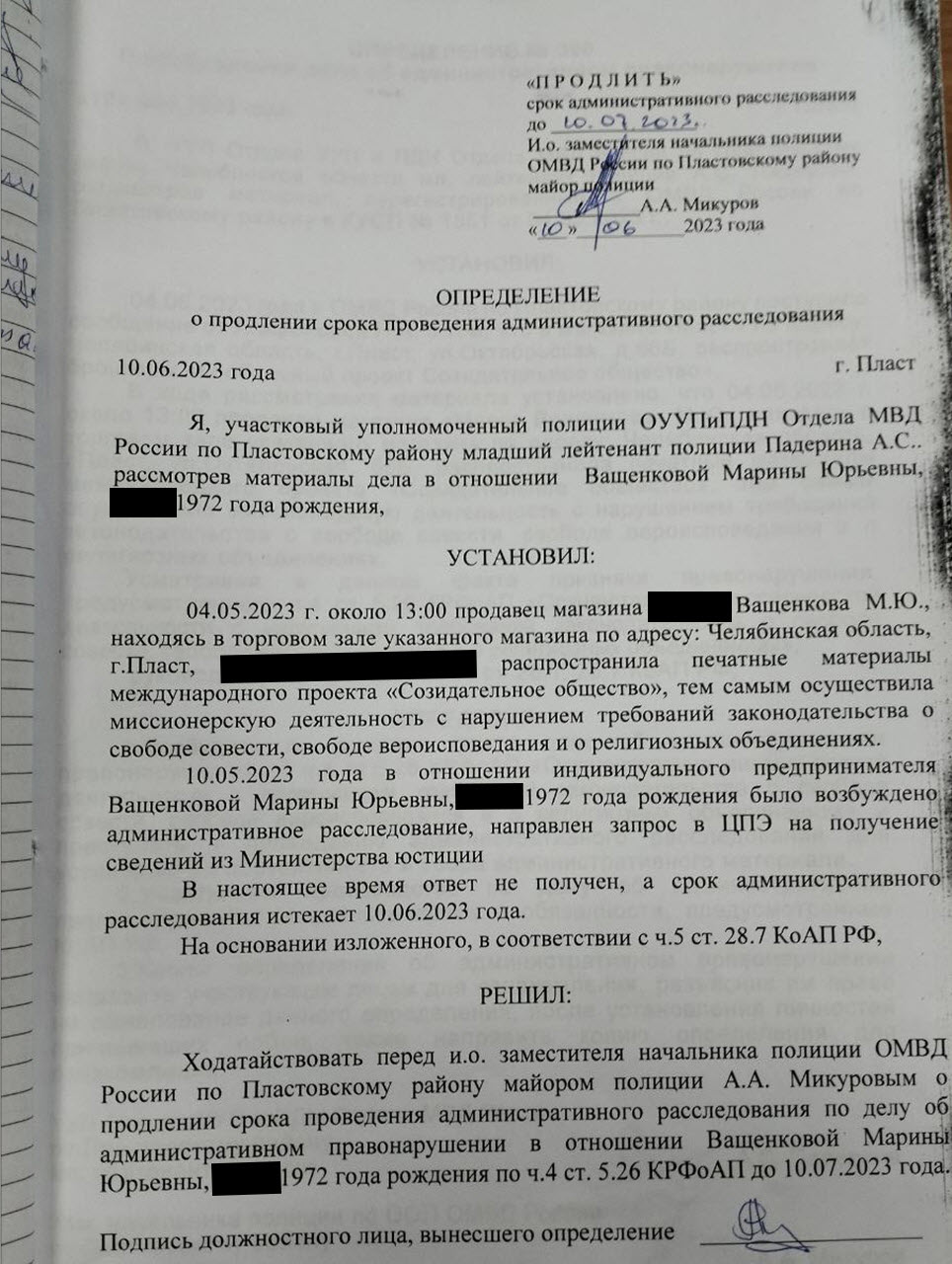
Photo 15: Decision to extend the administrative investigation period, dated June 10, 2023, issued by junior police lieutenant A.S. Paderina, district officer of the Department for Juvenile Affairs and Preventive Work of the Plast District Department of Internal Affairs, Chelyabinsk Region
The signature line marked “Signature of the official who issued the decision” bears the signature of A.S. Paderina. However, according to Part 5, Article 28.7 of CAO RF, such an extension must be issued by the head of the authority handling the administrative case or their deputy, and only upon the PETITION of the official conducting the investigation. In other words, CAO RF requires two documents to extend the administrative investigation period: a petition from the official in charge of the case and a decision issued by the head of the relevant authority or their deputy. Here, the case file contains only one document related to the extension of the administrative investigation, and by its form and content, it cannot be classified as the procedural document titled “Decision to extend the administrative investigation period.”
In violation of Part 5 of Article 28.7 of CAO RF, the maximum allowable duration of the administrative investigation was exceeded. That duration may not exceed one month from the initiation of an administrative case and can only be extended in exceptional cases upon a written petition from the official conducting the investigation. No such exceptional circumstances are indicated in the case materials.
In fact, the procedural actions required by law during the investigation period were not carried out by district officer A.S. Paderina and were possibly intentionally delayed, as the requests to the Center for Combating Extremism of the Main Directorate of the Ministry of Internal Affairs of Russia for Chelyabinsk Region to obtain information from the Ministry of Justice were sent as follows:
- request for information on the organization Creative Society — May 20, 2023 — only after 10 days had passed since the initiation of the case (May 10, 2023) [Volume 1, p. 27, Photo 16].
This raises a question: Was Paderina not able to submit the request herself directly to the Ministry of Justice? Is she not literate?
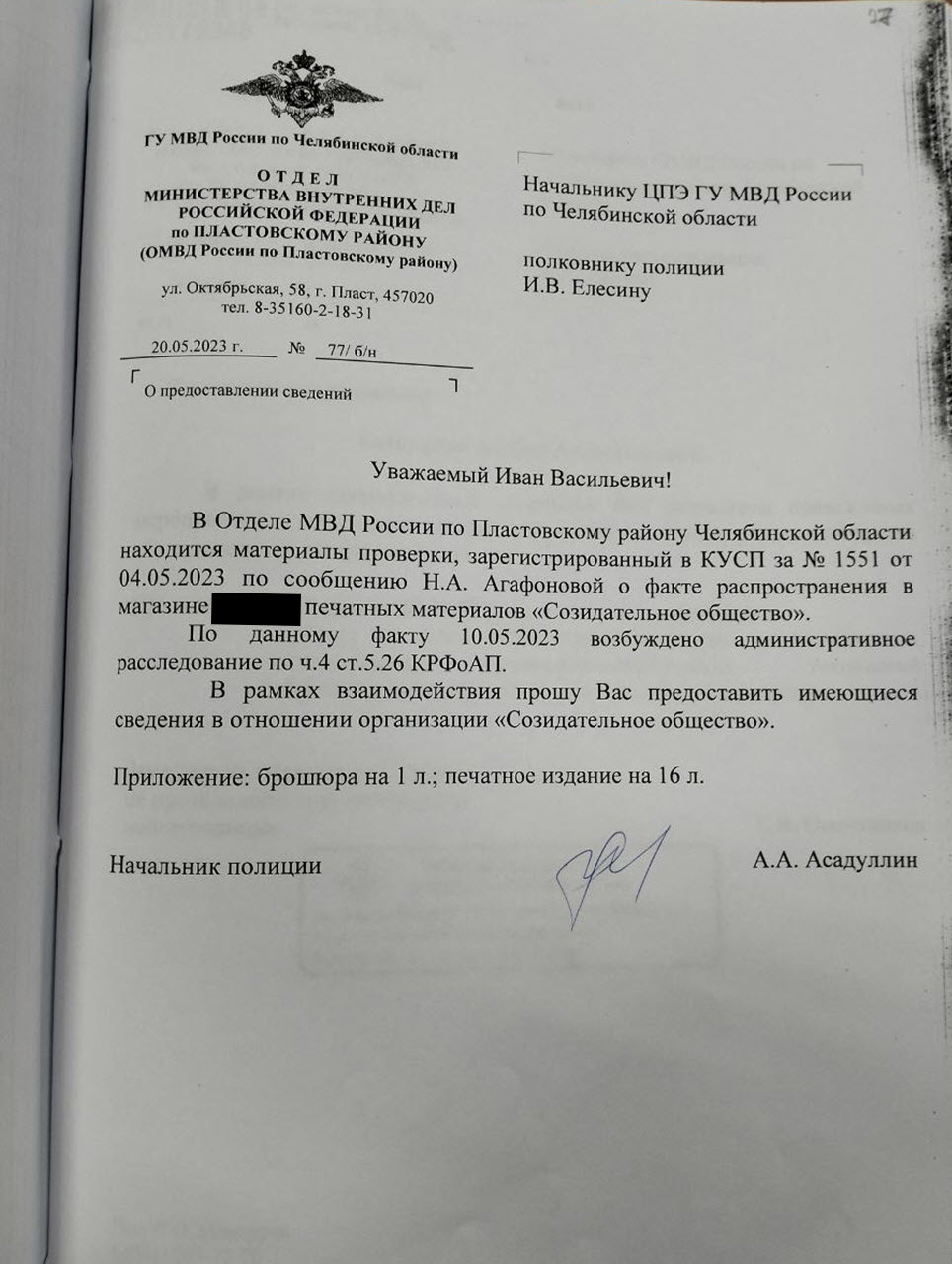
Photo 16: Request for information on the organization Creative Society, submitted to the Center for Combating Extremism of the Main Directorate of the Ministry of Internal Affairs of Russia for Chelyabinsk Region, dated May 20, 2023, No. 77/b/n
- request for information regarding M.Yu. Vashchenkova as a founder or head of a religious organization — June 8, 2023 — only after 29 days had passed since the initiation of the case (May 10, 2023) [Volume 1, p. 33, Photo 17].
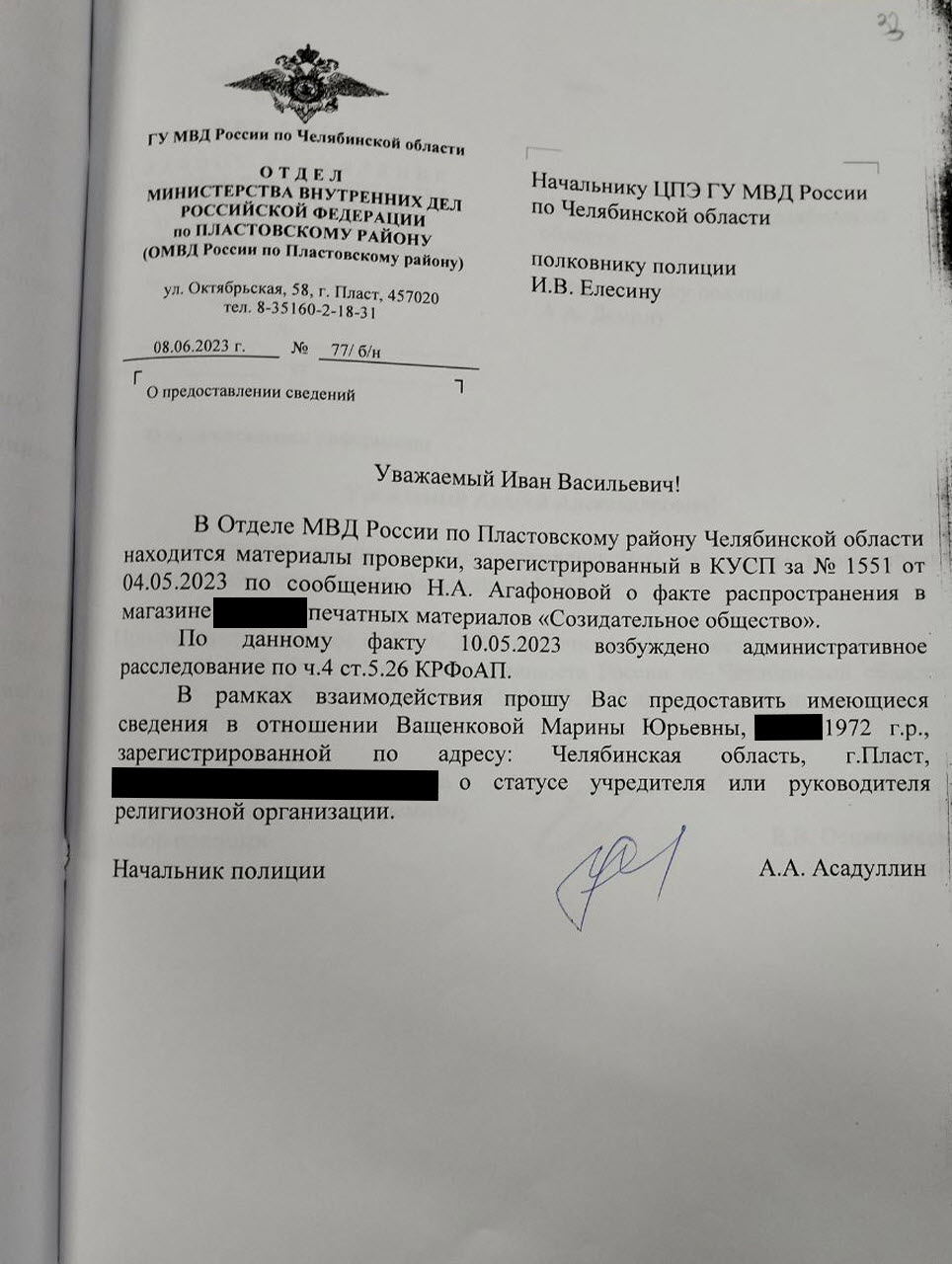
Photo 17: Request for information regarding M.Yu. Vashchenkova as a founder or head of a religious organization, dated June 8, 2023, No. 77/b/n
As stated in paragraph 3, subsection “a” of Section 3 of the Resolution No. 5 of the Plenum of the Russian Federation Supreme Court, dated March 24, 2005, “About some questions arising at courts in case of application of the Russian Federation Code of Administrative Offenses,” an administrative investigation constitutes a set of procedural actions carried out by the abovementioned officials, requiring significant time and aimed at establishing all the circumstances of an administrative offense, recording them, providing legal qualification, and formalizing them procedurally. The conduct of an administrative investigation must consist of real actions aimed at obtaining the necessary information, including through expert assessment, identification of victims or witnesses, and questioning of individuals who reside in other localities.
Given these circumstances, it may be concluded that there were no exceptional grounds for extending the administrative investigation period, and the decision dated June 10, 2023, to extend that period is unlawful and unfounded.
The case materials do NOT indicate that, in the course of proceedings in the administrative offense case, the Plast District Department of Internal Affairs, Chelyabinsk Region, conducted an expert assessment or carried out a thorough examination or analysis of the content of the means by which the administrative offense had been allegedly committed (printed materials seized with the involvement of N.A. Agafonova). This constitutes a serious procedural violation in the legal qualification of the actions of M.Yu. Vashchenkova under Part 4 of Article 5.26 of CAO RF. In other words, police officer A.S. Paderina failed to carry out the necessary procedural steps that would have made it possible to clearly establish that the actions of M.Yu. Vashchenkova bore elements of the offense she was charged with (illegal missionary activity).
Unlawful Collection of Statements by Police Chief Outside Procedural Framework and Violation of the Rights of the Accused
On June 27, 2023 (exact time not indicated), police chief A.A. Asadullin of the Plast District Department of MIA of Russia in Chelyabinsk Region collected a statement from M.Yu. Vashchenkova again [Vol. 1, p. 17, Photo 18].
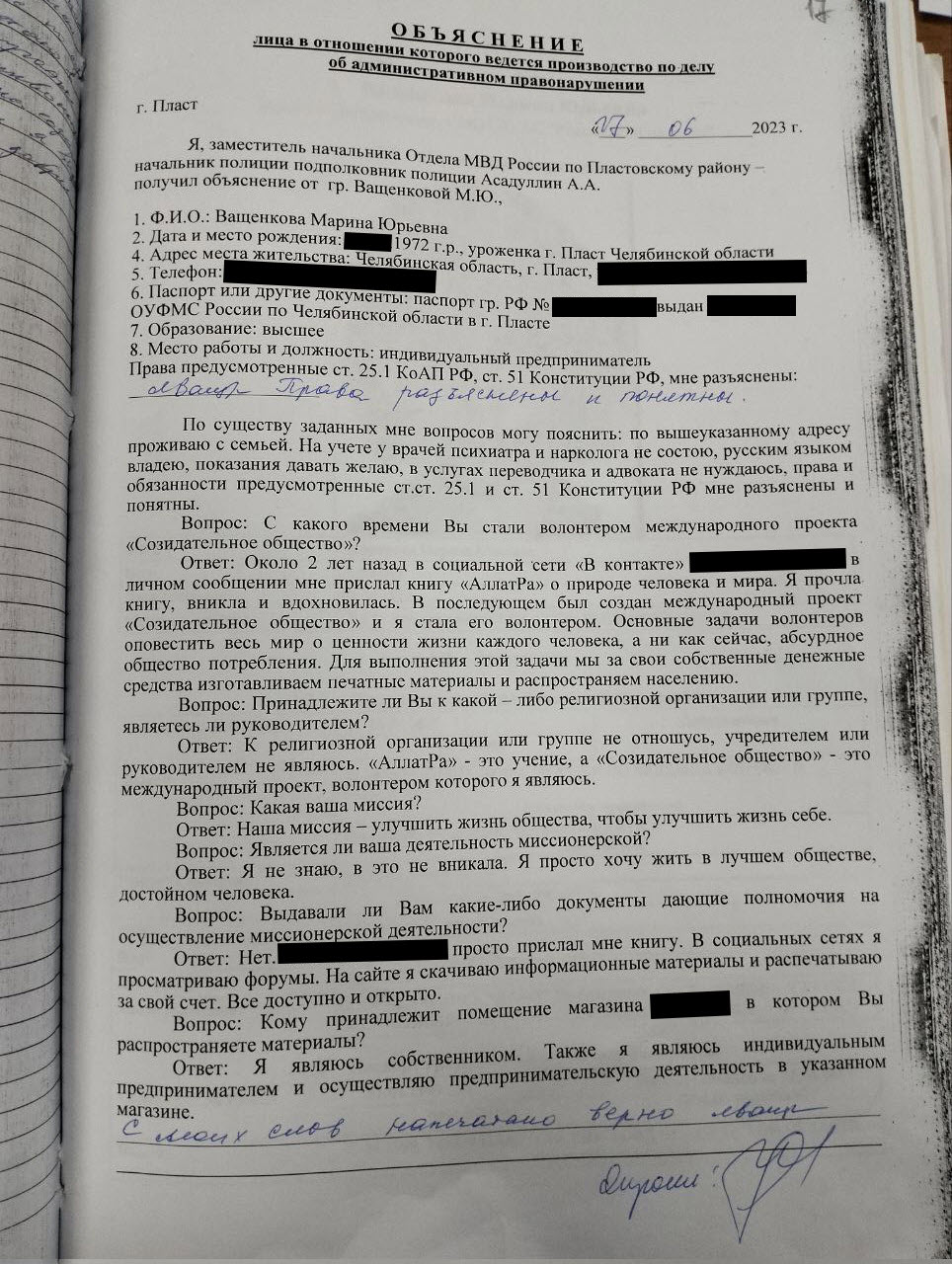
Photo 18: Statement from M.Yu. Vashchenkova, dated June 27, 2023, collected by police chief A.A. Asadullin, Plast District Department of MIA of Russia in Chelyabinsk Region
The initial statement had been collected by precinct police officer S.S. Kartsev on May 4, 2023 [Vol. 1, p. 16, Photos 19-20].
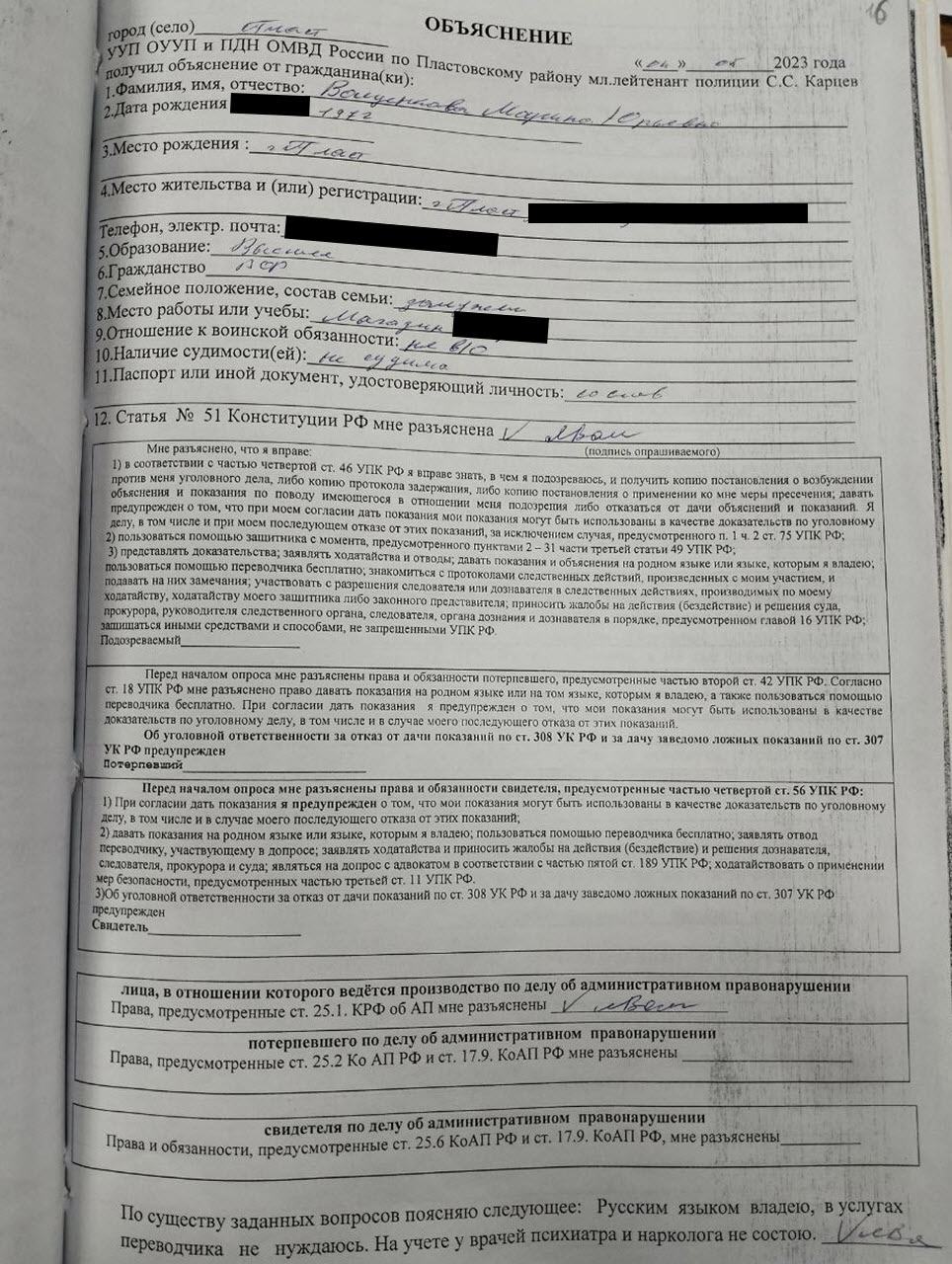
Photo 19: Statement from M.Yu. Vashchenkova, dated May 4, 2023, collected by precinct police officer S.S. Kartsev, part 1
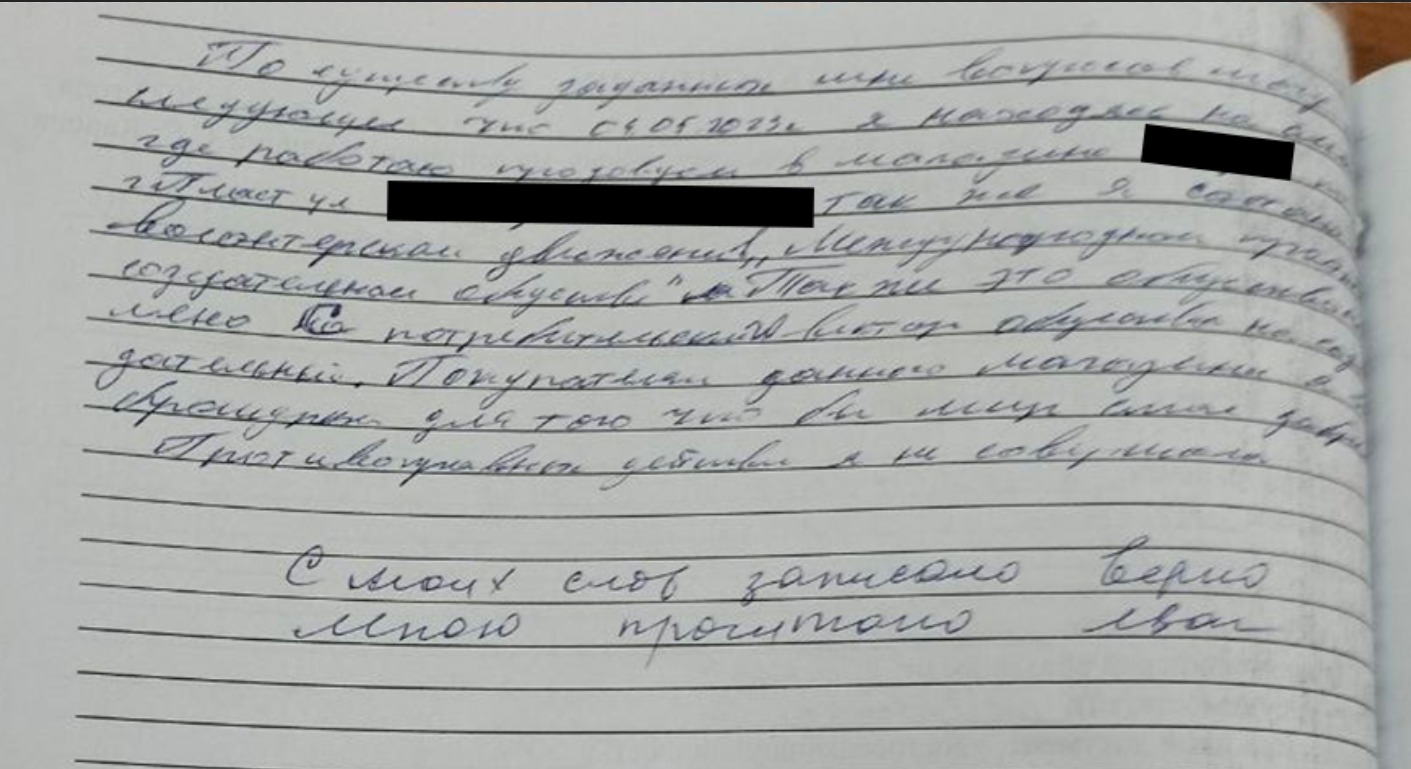
Photo 20: Statement from M.Yu. Vashchenkova, dated May 4, 2023, collected by precinct police officer S.S. Kartsev, part 2
- It is unclear on what legal grounds the police chief himself (A.A. Asadullin) and not the official who handled the case materials (A.S. Paderina) again collected the statement, or why a second statement was required at all. It should be noted that CAO RF does not contain any provision for reinterrogation of an individual subject to administrative liability. In other words, police chief Asadullin had no authority to question M.Yu. Vashchenkova a second time. Moreover, he had NO legal grounds to collect a statement from her in ANY capacity, as the case was under the jurisdiction of precinct police officer A.S. Paderina.
- On June 27, 2023, A.A. Asadullin invited M.Yu. Vashchenkova to the Plast District Department of MIA for a conversation, without specifying her procedural status or indicating in what capacity or for what purpose she was being summoned. By doing so, he misled her and violated the requirements of CAO RF.
- While reinterrogating M.Yu. Vashchenkova, Asadullin did not explain the nature of the procedural action being conducted, nor did he inform her of her rights prior to initiating the procedure, which is another obvious violation of CAO RF requirements.
- The answers provided by M.Yu. Vashchenkova, recorded in the statement dated June 27, 2023, were taken out of context and not fully or accurately reflected by Asadullin.
- Only after she signed the statement did Asadullin tell M.Yu. Vashchenkova that the statement would be submitted to the court. She reacted with indignation, not understanding how such a thing could happen or how she could be considered a violator. But it appears that Asadullin needed to fulfill a task assigned by RACIRS, which is likely why he committed such a blatant violation of the law.
Second Statement by the Alleged Victim — Now a Witness — Lacked Identity Verification and Officer Signature, but Was Admitted as Evidence by the Court
On June 28, 2023 (exact time not indicated), a second statement was taken from N.A. Agafonova, born in 1947, by precinct police officer A.S. Paderina from the Department for Juvenile Affairs and Preventive Work, Plast District Department of MIA of Russia in Chelyabinsk Region. This time, Agafonova was questioned not as a victim, but as a witness. The statement contains neither her passport information nor any other form of identification. In other words, the witness was not properly identified. Though signed by Agafonova, the statement does not bear the signature of officer Paderina, which invalidates it as admissible evidence. This second statement also presents a new version of the incident: “... When I entered the store, there was a fair-haired woman, about 40 to 50 years old, who was the salesperson. She gave me a newspaper and a brochure and told me to read them. I asked if it was a sect. She said no. When I got home and read the materials, I didn’t like the statements there. I ask that they stop spreading their rules of the ‘Creative Society’.” [Vol. 1, p. 3, Photos 21-22]
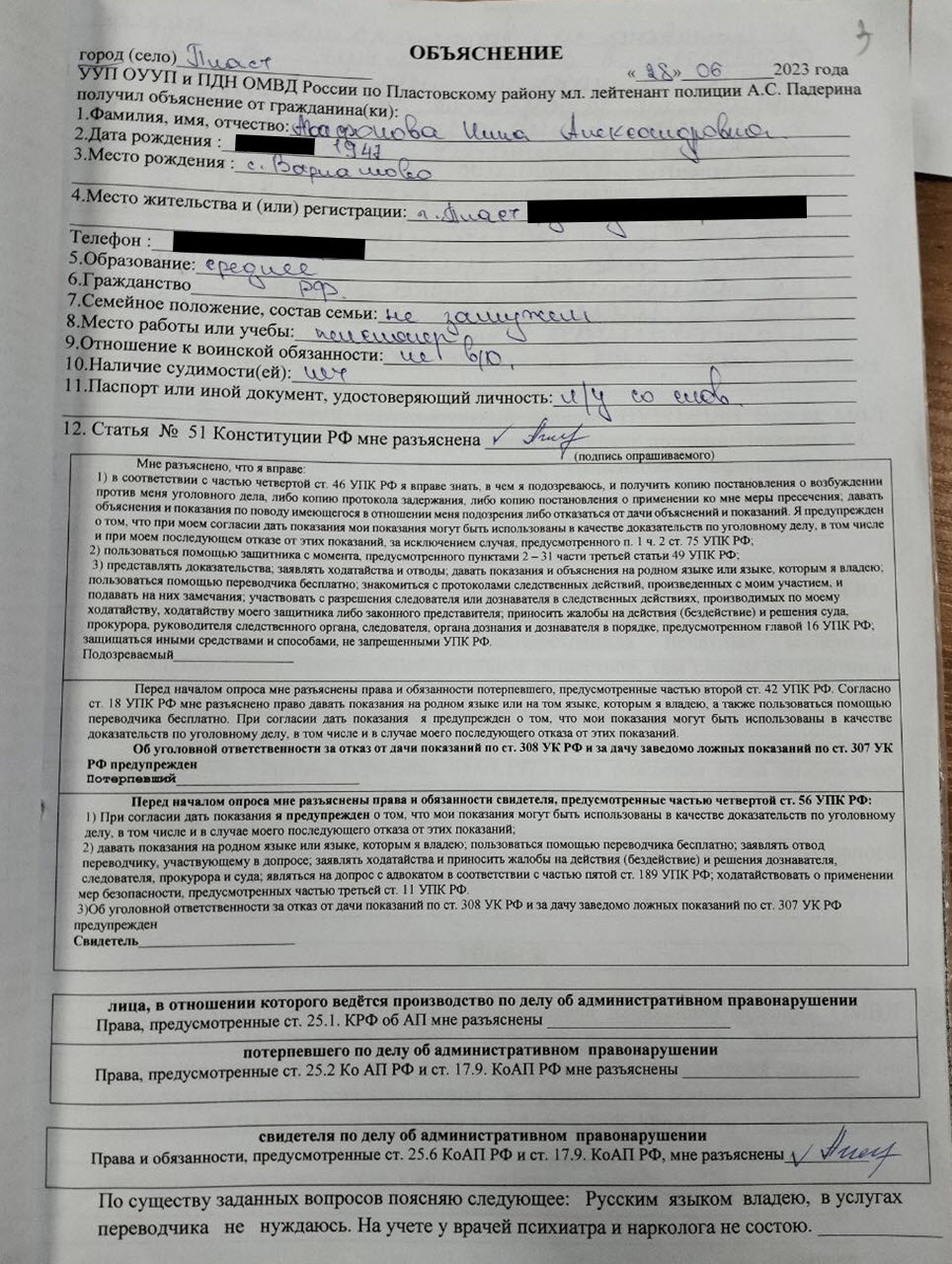
Photo 21: Statement from N.A. Agafonova, dated June 28, 2023, collected by precinct police officer A.S. Paderina from the Department for Juvenile Affairs and Preventive Work, Plast District Department of MIA of Russia in Chelyabinsk Region, part 1

Photo 22: Statement from N.A. Agafonova, dated June 28, 2023, collected by precinct police officer A.S. Paderina from the Department for Juvenile Affairs and Preventive Work, Plast District Department of MIA of Russia in Chelyabinsk Region, part 2
There is no information in this statement that connects specifically M.Yu. Vashchenkova to the case. The phrase “a fair-haired woman, about 40 to 50 years old, who was the salesperson” provides no meaningful detail. It could easily describe a random woman who, at some unspecified time and place — possibly on another planet — acted as a salesperson, and even that is merely Agafonova’s subjective impression. Nor is it clear from the statement what exactly Agafonova found objectionable in the printed materials: structure of sentences, style, images, layout, or actual content.
Despite the aforesaid inconsistencies and the new version presented in the second statement, the court failed to assess the evident discrepancies between this document and Agafonova’s original statement dated May 4, 2023. Ultimately, the court unjustifiably admitted both the initial and the second statement as valid evidence of M.Yu. Vashchenkova’s guilt, in violation of Article 26.2 of CAO RF.
Gross Violations in the Preparation of the Administrative Offense Protocol Invalidate All Subsequent Actions of the Police
On June 28, 2023, junior police lieutenant A.S. Paderina, precinct police officer at the Department for Juvenile Affairs and Preventive Work, Plast District Department of MIA of Russia in Chelyabinsk Region, drew up the administrative offense protocol No. 3023/000217 [Volume 1, p. 2, Photo 23].
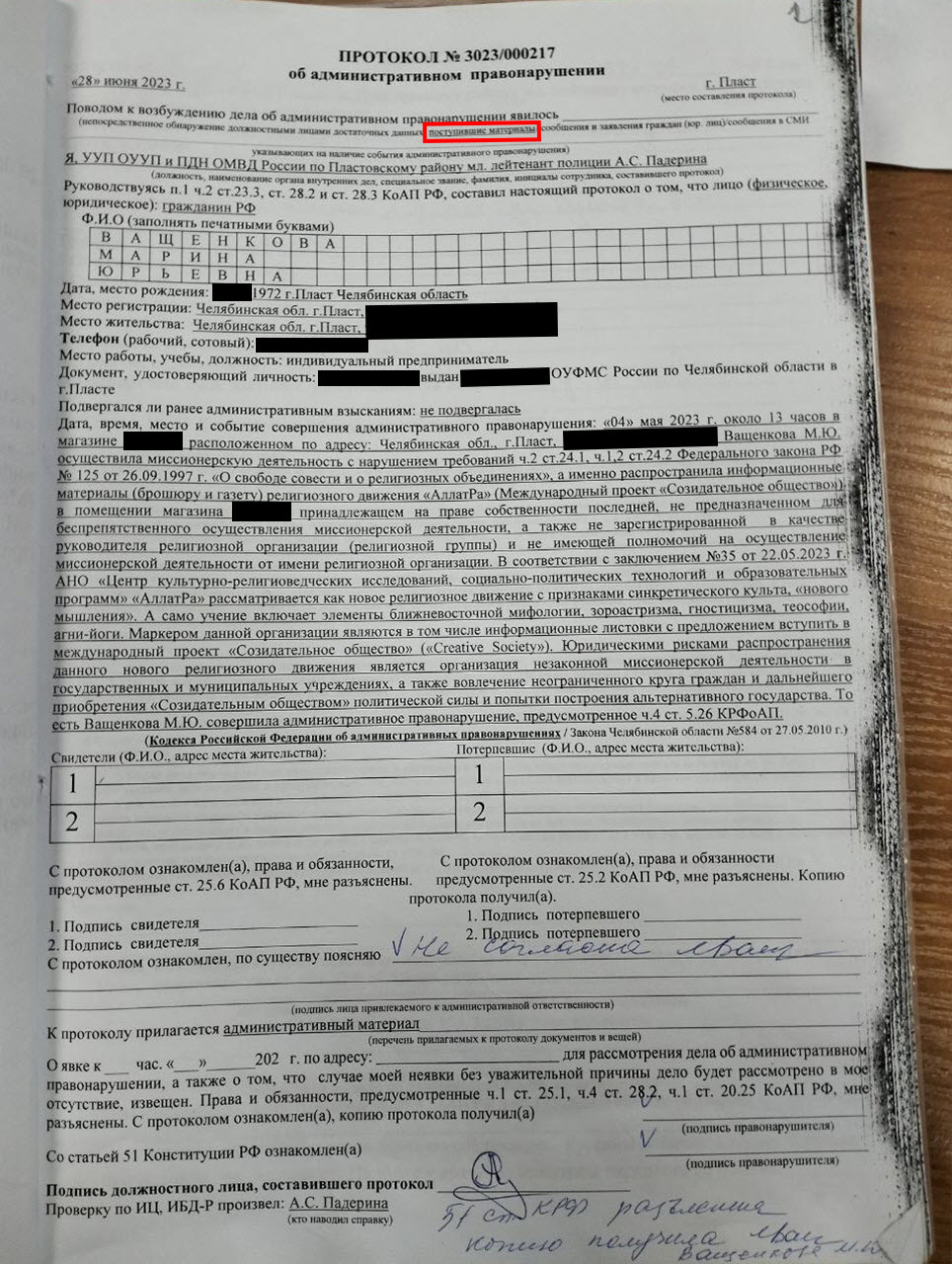
Photo 23: Administrative offense protocol No. 3023/000217 dated June 28, 2023, prepared by precinct police officer and junior lieutenant A.S. Paderina from the Department for Juvenile Affairs and Preventive Work, Plast District Department of MIA of Russia in Chelyabinsk Region
In drawing up the protocol, multiple egregious violations of CAO RF were committed, including:
- The protocol dated June 28, 2023, does not indicate the grounds for initiating an administrative offense case (this section is left blank), which confirms the absence of the complaint regarding the offence and the unlawfulness of drafting the protocol. Moreover, instead of citing “citizens’ reports or statements,” the protocol refers to “submitted materials,” further confirming the absence of a valid complaint and the illegitimacy of the protocol. According to Part 2, Article 28.3 of CAO RF, police officers are authorized to draw up protocols under Article 5.26 of CAO RF only when there is a report from a citizen or organization. Thus, officer A.S. Paderina was not legally authorized to draw up this protocol (in violation of Paragraph 1, Part 2, Article 28.3 of CAO RF).
- Upon reviewing the documents drawn up by Paderina, the defense side noted glaring legal and professional incompetence on her part, evident even in basic matters, such as the abbreviation for the code under which M.Yu. Vashchenkova was charged. Russian legislation establishes the proper abbreviation for the Code of Administrative Offenses of the Russian Federation as CAO RF. According to Section 1 of the Resolution No. 5 of the Plenum of the Russian Federation Supreme Court, dated March 24, 2005, “About some questions arising at courts in case of application of the Russian Federation Code of Administrative Offences,” the legislative framework that must be applied in such cases is the Code of Administrative Offenses of the Russian Federation (hereinafter referred to as CAO RF). However, Paderina invented her own abbreviation: CRFAO — an apparent mockery of Russian law by a law enforcement officer. Consequently, the accusation against M.Yu. Vashchenkova was based on a nonexistent law, effectively charging her under a phantom statute.
- In the administrative offense protocol No. 3023/000217, dated June 28, 2023, the description of the offense nature fails to specify the method by which the newspaper and brochure were distributed, i.e. how the alleged missionary activity was carried out. (What exactly did M.Yu. Vashchenkova do? Did she stuff them into pockets or paste them on the foreheads of store visitors?) There is no indication of any concrete connection between the alleged act and Vashchenkova’s behavior. Police officer A.S. Paderina must have specified something like: “by handing the newspaper and brochure from citizen M.Yu. Vashchenkova directly to citizen N.A. Agafonova” and/or “she talked about…” As for the “newspaper,” nothing in the case files points to the existence of such an item. Instead, there is a reference to an unidentified object labeled “gaSHeta” — a nonsensical term that refers to something unknown to modern civilization and clearly unrelated to the case. Therefore, even the mention of a newspaper in the protocol is legally baseless. The protocol fails to specify what exactly in Vashchenkova’s actions was illegal. Identifying the unlawful element in the behavior of the accused is essential to establishing the occurrence of an administrative offense.
- When describing the alleged offense in the protocol No. 3023/000217, A.S. Paderina refers to Conclusion No. 35 dated May 22, 2023, from ANO “Center for Cultural and Religious Studies, Socio-Political Technologies, and Educational Programs.” But what kind of conclusion is this — personal or expert? If it is implied to be expert, no official expert assessment was assigned in this case as required under Article 26.4 of CAO RF. CAO RF does not recognize any other types of conclusions, which makes the reference to this so-called expert conclusion unlawful, invalidating the entire evidentiary chain that follows. The case files only include a certificate from this organization, which, in both its form and content, does not meet the legal criteria for an expert opinion.
- Attached to the protocol is a mysterious “administrative material” (some sort of a new know-how paper) instead of the required investigative case materials for an administrative offense.
- In violation of Part 3, Article 28.2 of CAO RF, the rights and responsibilities of M.Yu. Vashchenkova as the accused were not explained to her. This is confirmed by the absence of a corresponding notation or any indication of a refusal to sign in the appropriate sections of the protocol, in violation of Part 5, Article 28.2 of CAO RF. Simply handing over a copy of the protocol for signing does not absolve the official of the duty to explain the accused’s rights. This is a severe procedural violation!
- The protocol further lacks personal data of any witnesses or victims (names and residential addresses), while N.A. Agafonova is listed in the case materials as a witness in some documents and a victim in others. This violates Part 2, Article 28.2 of CAO RF. According to paragraph 2, Section 4 of the Resolution No. 5 of the Plenum of the Russian Federation Supreme Court, dated March 24, 2005 (as amended on December 23, 2021), “About some questions arising at courts in case of application of the Russian Federation Code of Administrative Offences,” the absence of the information expressly required by Part 2, Article 28.2 of CAO RF constitutes a material deficiency in the protocol.
- In addition, N.A. Agafonova was not informed of her rights or duties as either a victim or witness as required under CAO RF. This is evident from the absence of her signature in relevant sections of the protocol, constituting a violation of Part 3, Article 28.2 of CAO RF. Therefore, without a witness or a victim, there is no offense. (Or did law enforcement establish the fact of the violation through a séance?)
- The protocol also fails to state whether M.Yu. Vashchenkova speaks the language in which the case proceedings were conducted. As noted in paragraph 2, Section 4 of the Resolution No. 5 of the Plenum of the Russian Federation Supreme Court, dated March 24, 2005 “About some questions arising at courts in case of application of the Russian Federation Code of Administrative Offences,” the absence of data listed in Part 2, Article 28.2 of CAO RF and other relevant details depending on their significance for a particular case of administrative offense (such as whether the accused understands the language of the proceedings, or whether an interpreter was provided, etc.) constitutes a material deficiency in the protocol.
- There were also gross violations of the deadline for executing the administrative offense protocol. Under Article 28.5 of CAO RF, an administrative offense protocol must be drawn up immediately upon identification of an administrative offense. If additional fact-finding or personal data verification of the individual or information on the legal entity in respect of which the administrative offense case is being initiated is required, the protocol must be executed within two days of the offense being discovered. Given that the alleged administrative offense was identified on May 4, 2023, and that Article 28.7 of CAO RF does not allow for administrative investigations in cases under Part 4, Article 5.26 of CAO RF, the administrative offense protocol must have been executed no later than May 6, 2023.
The administrative offense protocol was issued more than a month and a half past the legal deadline. For offenses under Part 4, Article 5.26 of CAO RF, the case is considered initiated at the time the protocol is executed and does not allow for an administrative investigation. Therefore, by May 11, 2023, acting on the instructions of A.A. Asadullin, the responsible officer must have determined whether the actions of M.Yu. Vashchenkova constituted illegal missionary activity. Based on that determination, the officer must have either drawn up a protocol or refused to initiate the case. Instead, on May 10, 2023, A.S. Paderina unlawfully issued a resolution to initiate an administrative offense case and launched an administrative investigation. As a result, all procedural actions carried out by the police after May 10, 2023, have been unlawful.
- The circumstances of the alleged administrative offense as stated in the protocol are not supported by the materials collected. Moreover, those materials contain numerous inconsistencies. This confirms that officer A.S. Paderina unlawfully issued the protocol, as the case files do not establish that any offense occurred on the part of M.Yu. Vashchenkova.
Violation of the Right to Defense: The Case Was Illegally Considered Despite Procedural and Factual Errors
On June 29, 2023, acting police chief (deputy chief of the public order police) major A.A. Mikurov from the Plast District Department of MIA of Russia in Chelyabinsk Region, issued a resolution to transfer the administrative offense case to Judicial District No. 1 of Plast, Chelyabinsk Region, against “ashchenkova ...,” born on ** **, 1974. However, the actual surname of the accused is Vashchenkova, while her actual year of birth is 1972. In other words, the case was forwarded to court for consideration against an entirely different person, with a different surname and date of birth [Vol. 1, p. 1, Photo 24].
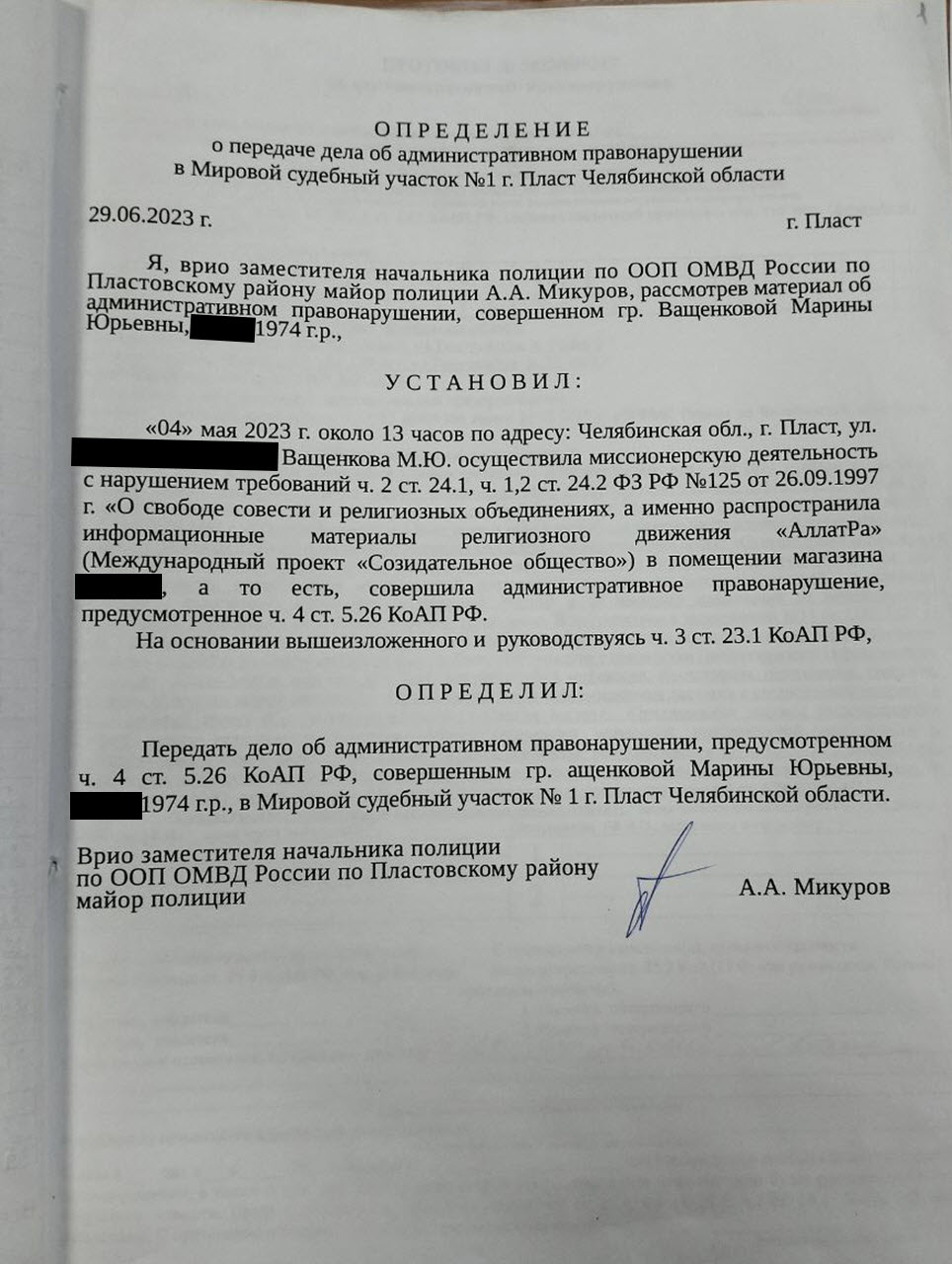
Photo 24: Resolution on the transfer of the administrative offense case to Judicial District No. 1 of Plast, Chelyabinsk Region, dated June 29, 2023, issued by acting police chief (deputy chief of the public order police) major A.A. Mikurov from the Plast District Department of MIA of Russia in Chelyabinsk Region
Furthermore, this resolution states that M. Yu. Vashchenkova distributed informational materials of the religious movement AllatRa. However, the case files do not confirm that the printed materials seized in the presence of N.A. Agafonova contain any mention of AllatRa or of any religious organization whatsoever.
On July 3, 2023, justice of the peace Sergey Pridannikov, Judicial District No. 1 of the city of Plast, Chelyabinsk Region, issued a resolution to schedule the hearing of the administrative offense case for July 6, 2023 [Vol. 1, p. 40, Photo 25]. However, according to Article 29.4 of CAO RF, the judge must have issued a resolution on returning the protocol and the case materials to the agency or official who had executed the protocol.
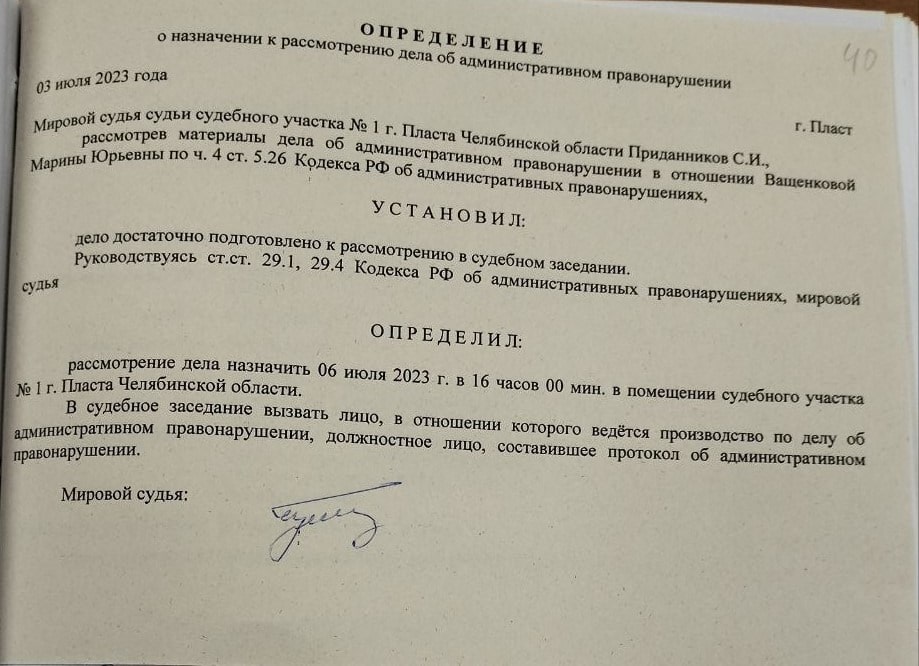
Photo 25: Resolution dated July 3, 2023, issued by JP Sergey Pridannikov, Judicial District No. 1 of the city of Plast, Chelyabinsk Region, scheduling the hearing of the administrative offense case for July 6, 2023
According to paragraph 4, Part 1, Article 29.4 of CAO RF and the legal position set forth in Section 4 of the Resolution No. 5 of the Plenum of the Russian Federation Supreme Court, dated March 24, 2005, “About some questions arising at courts in case of application of the Russian Federation Code of Administrative Offences,” if an administrative offense protocol is executed by an unauthorized person, or if the protocol or other materials are improperly executed or incomplete, the judge must issue a ruling to return the protocol and case materials to the agency or official that executed them.
In the case discussed, the aforesaid substantial violations in the execution of protocols and other case materials, as well as the lack of a properly conducted expert assessment of the printed materials seized in the presence of N.A. Agafonova, represented sufficient grounds for JP S. Pridannikov to return the materials for correction to the official who issued the protocol. In fact, this was a direct obligation of the judge under Clause 4, Part 1, Article 29.4 of CAO RF — an obligation he failed to fulfill. Despite the above-listed procedural violations in how the administrative offense case was conducted and documented, i.e. violations that resulted in a breach of the right to defense of the person subject to the proceedings, the justice of the peace failed to address them and unlawfully accepted the case for review.
Furthermore, Article 47, Part 1 of the Constitution of the Russian Federation states: “Nobody may be deprived of the right to have his (her) case heard in the court and by the judge within whose competence the case is placed by law.” Under Article 23.1, Part 1 of CAO RF, judges are authorized to consider cases involving administrative offenses, including those under Article 5.26 of CAO RF.
According to Section 3 of the Resolution No. 5 of the Plenum of the Russian Federation Supreme Court, dated March 24, 2005, “About some questions arising at courts in case of application of the Russian Federation Code of Administrative Offences,” during the preparation phase of a case, the judge must determine whether the case falls within their jurisdiction. When addressing the issue of subject-matter and territorial jurisdiction, judges must refer to Chapter 23 of CAO RF which outlines cases that fall under the jurisdiction of judges as per Article 23.1, Part 1 of CAO RF. It must also be taken into account that judges of district courts handle administrative offense cases listed in Parts 1 and 2 of Article 23.1 of CAO RF if an administrative investigation was conducted under Article 28.7 of CAO RF.
In this case, both Article 23.1 of CAO RF and Section 63 of Order No. 736 of the Russian Ministry of Internal Affairs, dated August 29, 2014, "On approving the Instruction on the procedure for receiving, registering and authorizing, in the territorial bodies of the Ministry of Internal Affairs of the Russian Federation, applications and reports on crimes, administrative offenses, and incidents, approved by Order of the Ministry of Internal Affairs," have been violated.
The case files clearly show that the administrative investigation was actually carried out, which means the case must have been considered by a district court judge. Therefore, according to paragraph 5, Part 1, Article 29.4 of CAO RF, the justice of the peace was required to issue a ruling to transfer the protocol and other case materials to the appropriate court by jurisdiction — namely, the Plast City Court of Chelyabinsk Region.
Reasonable Doubts Regarding the Authenticity of the Witness’s Signature and Signs of Possible Document Forgery
During the analysis of the case materials, the defense identified substantial doubts regarding the authenticity of the signature of the witness (alleged victim) N.A. Agafonova, as it appears in the following files:
- The protocol of seizure of items and documents, dated May 4, 2023, and the statement by N.A. Agafonova, dated May 4, 2023, both executed by junior police lieutenant S.S. Kartsev, precinct police officer of the Department for Juvenile Affairs and Preventive Work, Plast District Department of MIA of Russia in Chelyabinsk Region [Photos 26-27].
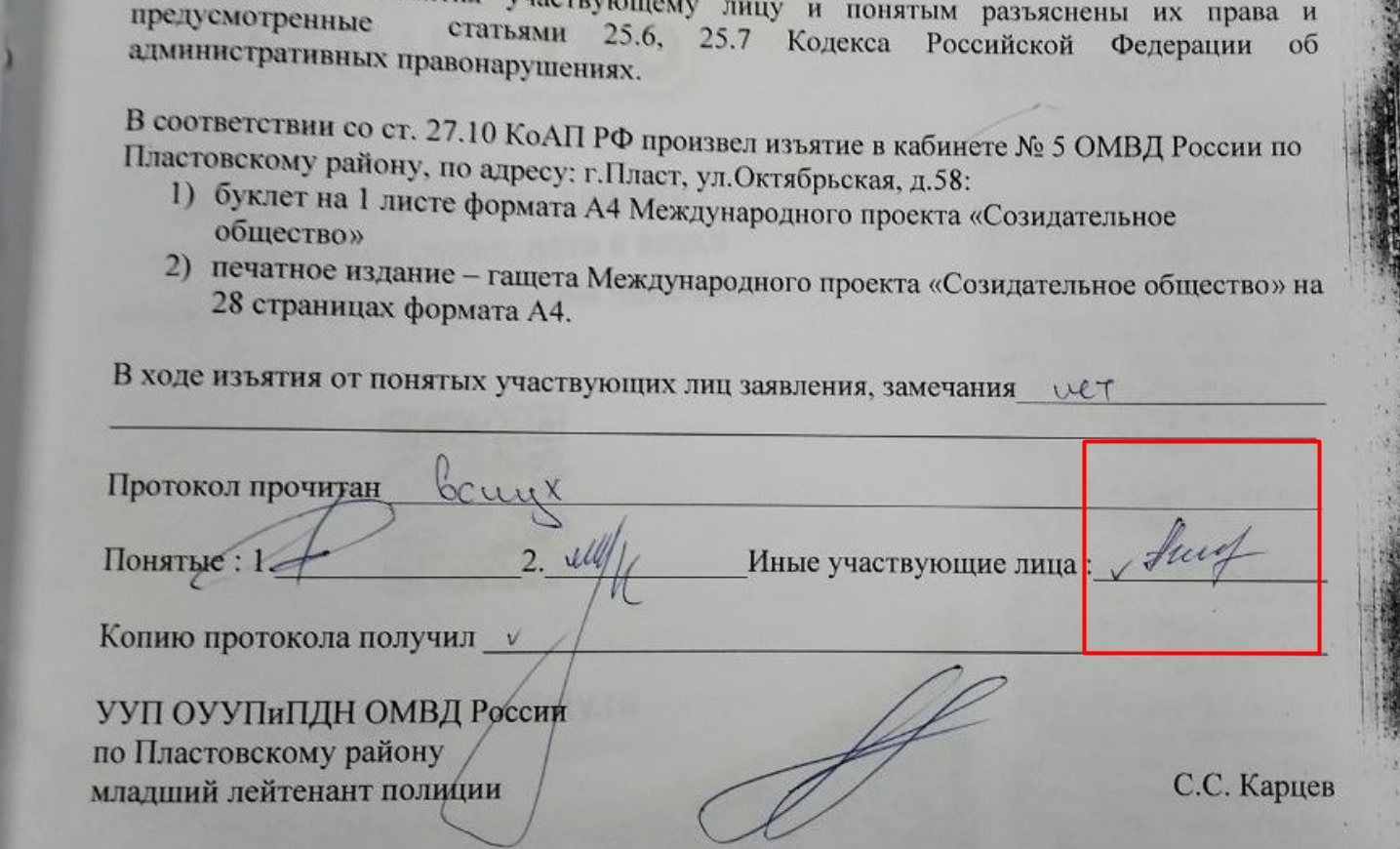
Photo 26: Protocol of seizure of items and documents, dated May 4, 2023
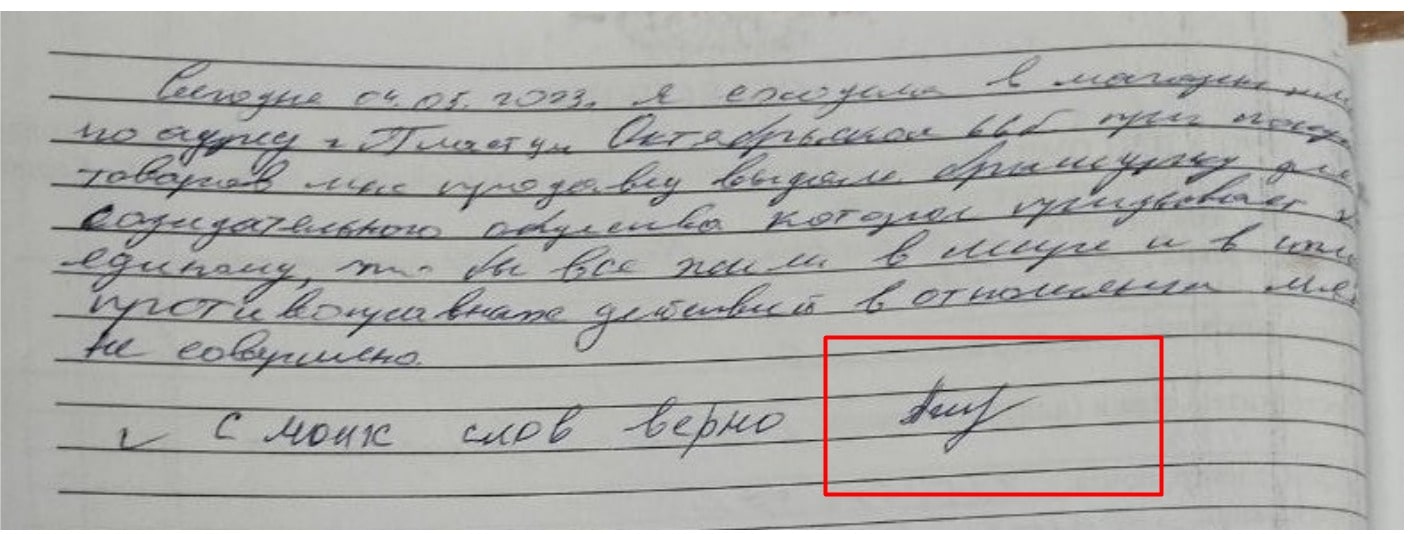
Photo 27: Statement by N.A. Agafonova, dated May 4, 2023, drawn up by junior police lieutenant S.S. Kartsev, precinct police officer of the Department for Juvenile Affairs and Preventive Work, Plast District Department of MIA of Russia in Chelyabinsk Region
- The statement by N.A. Agafonova, dated June 28, 2023 [Photo 28], drawn up by A.S. Paderina, precinct police officer of the Department for Juvenile Affairs and Preventive Work, Plast District Department of MIA of Russia in Chelyabinsk Region
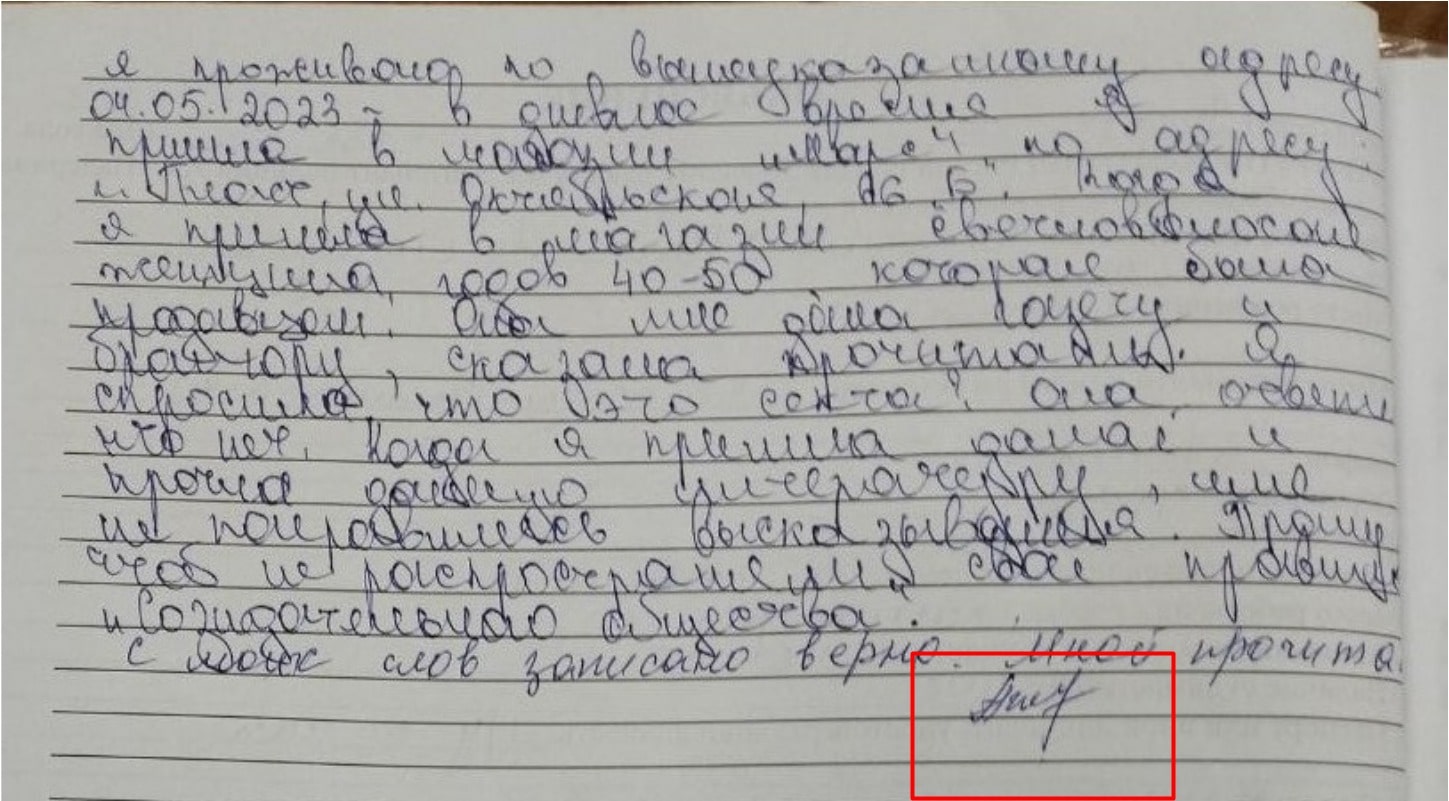
Photo 28: Statement by N.A. Agafonova, dated June 28, 2023
The signatures in question differ significantly in their visual and handwriting characteristics. Considering N.A. Agafonova’s age (76 at the time the documents were executed), visual features of the signatures do not match the expected motor skills of an elderly individual. On the contrary, the signatures appear more consistent with those of a younger person (with even, sharp lines and strong pen pressure). This gives rise to reasonable suspicion that the signatures might not have been made by N.A. Agafonova herself, but rather by another person, specifically the police officer who drew up the documents. Although a forensic handwriting examination has not yet been conducted, it is expected to be performed.
Given the lack of a forensic handwriting examination report in the case files and the possibility that evidence was falsified by someone signing the documents in place of N.A. Agafonova, the defense considers it impossible to recognize the signatures as reliable and admissible evidence without a proper expert analysis to determine whether the signatures in the procedural documents were indeed made by N.A. Agafonova. Should the signs of evidence falsification in the administrative case materials be confirmed, those responsible for the forgery will be subject to criminal liability under Article 303 of CC RF (Falsification of Evidence and Results of Investigative Activity).
Violations Committed by JP S.I. Pridannikov During the Case Consideration
In the course of reviewing the administrative offense case, JP Sergey Ilyich Pridannikov also committed a substantial violation of procedural law, as outlined below.
1. Hearing of the case without the participation of the person whose report triggered the administrative offense proceedings
Justice of the peace S.I. Pridannikov reviewed the case without the participation of N.A. Agafonova whose report led to the inspection conducted from May 4, 2023, to May 10, 2023, and to the initiation of the administrative offense case. Based on the case materials, N.A. Agafonova is either a victim — as indicated in her statement dated May 4, 2023 [Volume 1, p. 9, Photos 11-12] and in the letter dated May 10, 2023, No. 77/3961 [Volume 1, p. 15, Photo 29] — or a witness, as follows from Agafonova’s statement dated June 28, 2023 [Volume 1, p. 3, Photos 21-22].
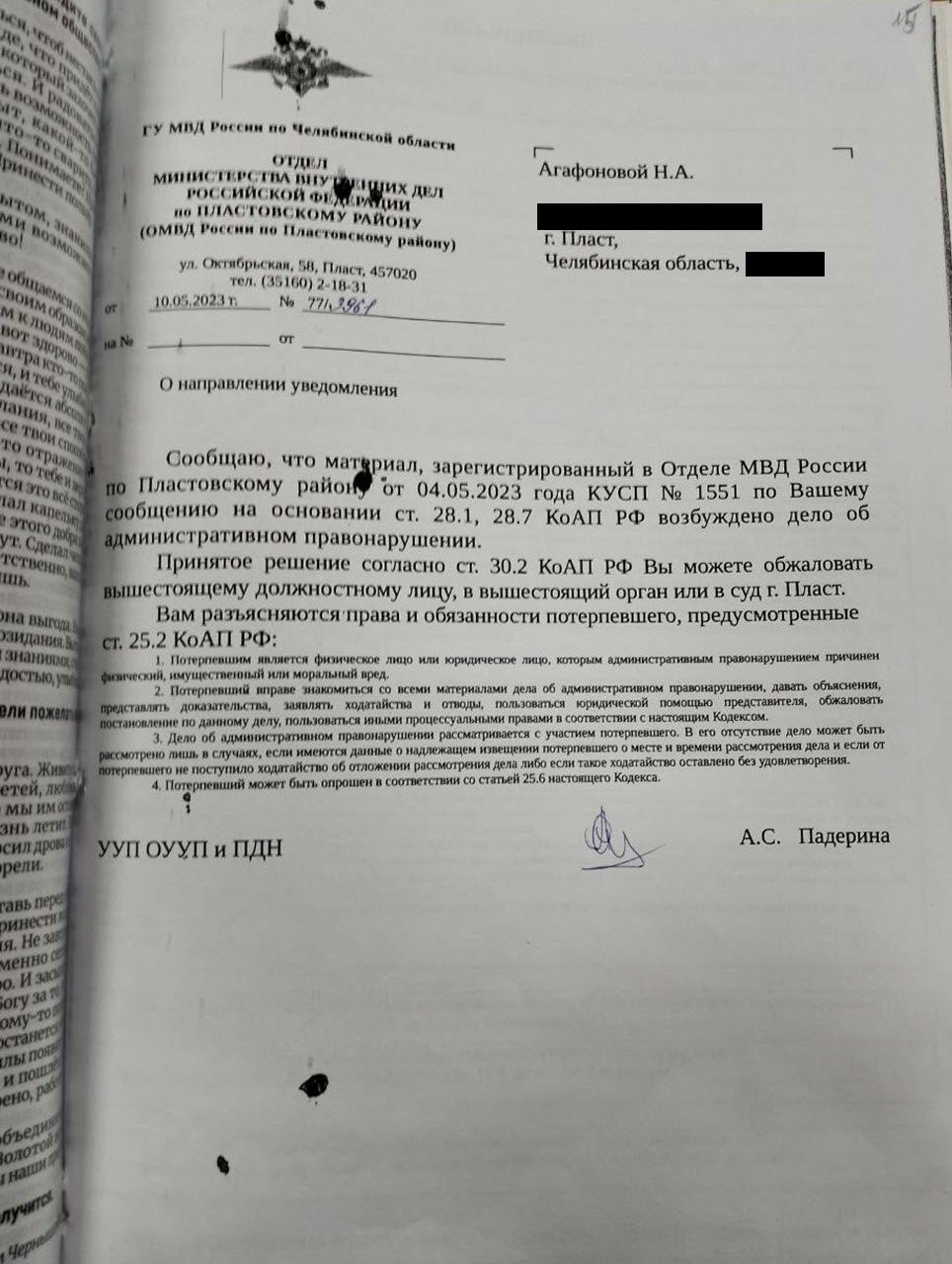
Photo 29: Letter regarding the dispatch of notification No. 77/3961 dated May 10, 2023, signed by precinct police officer A.S. Paderina, Department for Juvenile Affairs and Preventive Work, Plast District Department of MIA of Russia in Chelyabinsk Region
It should be noted that, in accordance with Article 25.2 of CAO RF, an administrative offense case is to be heard with the participation of the victim. In the victim’s absence, the case may only be considered if there is evidence that the victim was duly notified of the time and place of the hearing, and if no motion to postpone the hearing was filed by the victim, or if such a motion was denied. In this case, there is no information indicating that N.A. Agafonova was present during the hearing of the case by JP S.I. Pridannikov, nor is there any record of a motion from N.A. Agafonova requesting a postponement of the hearing.
In any event, the presence of N.A. Agafonova at the hearing was necessary to establish the factual circumstances of the administrative offense allegedly committed by M.Yu. Vashchenkova.
Since the defense had grounds to believe that citizen N.A. Agafonova had never submitted a complaint regarding the alleged unlawful actions of M.Yu. Vashchenkova under Part 4 of Article 5.26 of CAO RF which provides for liability for illegal missionary activity, the attorney representing M.Yu. Vashchenkova submitted a motion to summon the victim, N.A. Agafonova, to appear in court [Volume 1, p. 85, Photo 30].
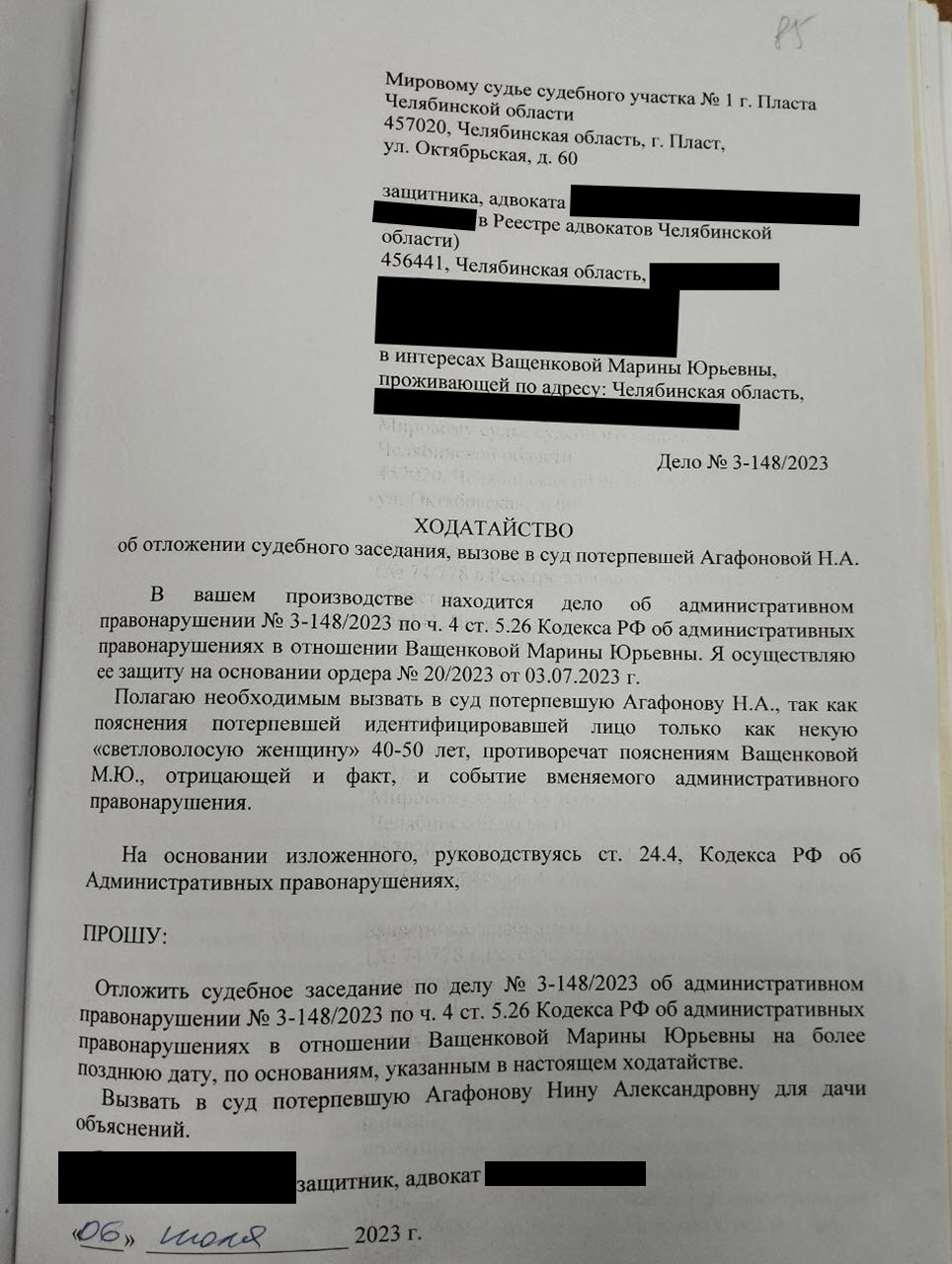
Photo 30: Motion to postpone the court hearing and to summon the victim, N.A. Agafonova, dated July 6, 2023
However, in a ruling dated July 10, 2023, the judge denied the motion to summon and question the witness on the grounds that, according to the individual who compiled the administrative offense protocol, N.A. Agafonova’s health had deteriorated [Volume 1, p. 113, Photo 31].
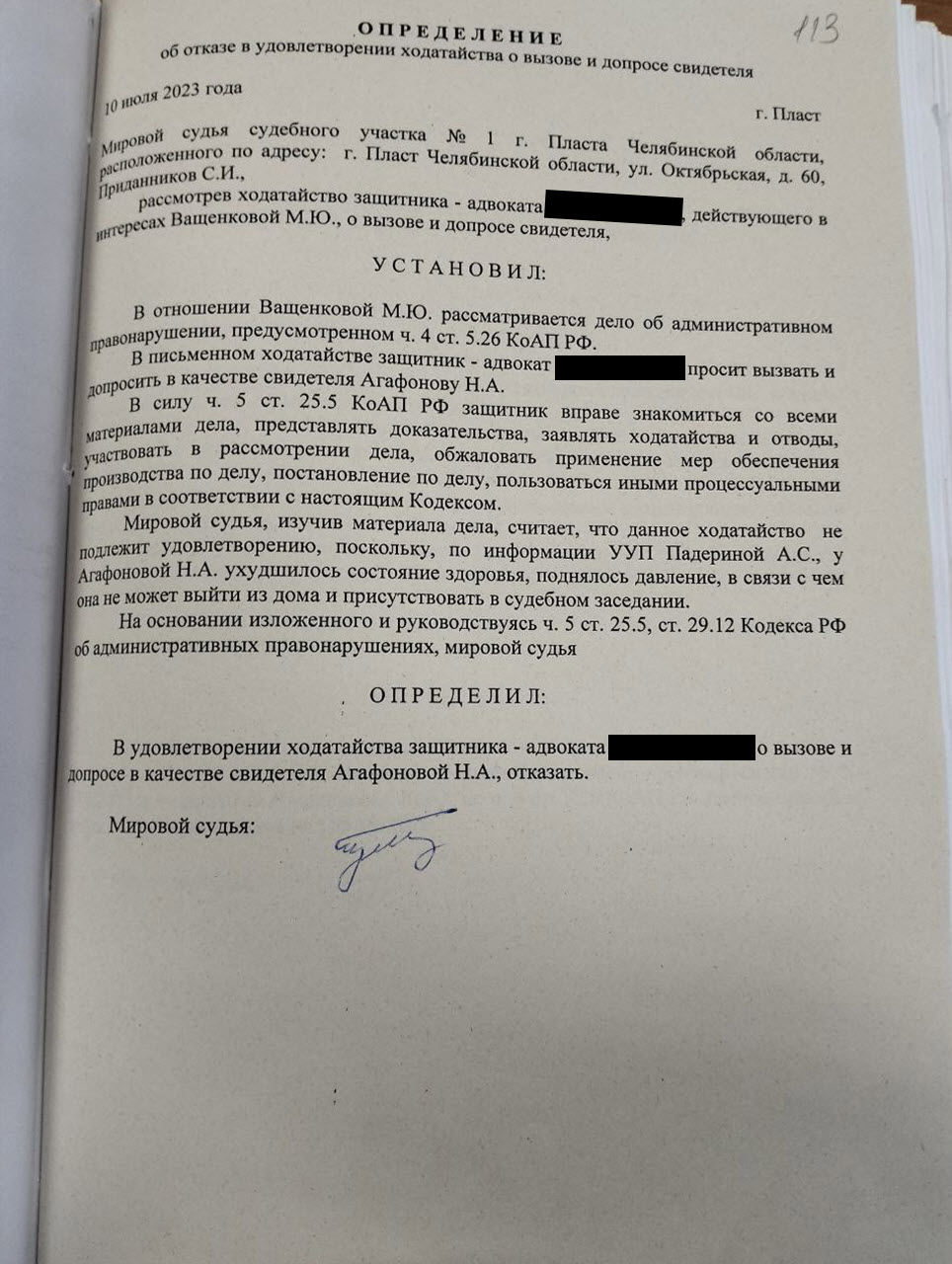
Photo 31: Ruling denying the motion to summon and question the witness, dated July 10, 2023, issued by JP S.I. Pridannikov
It should be noted that the case file contains neither a motion from N.A. Agafonova herself nor any evidence confirming her poor health. One might wonder: does precinct police officer A.S. Paderina also serve as a medical professional? And was it really sufficient for justice of the peace S.I. Pridannikov to rely solely on the words of district police officer A.S. Paderina, in lieu of a medical certificate regarding N.A. Agafonova’s health, to justify denying the motion to summon and question her? This means that the words of the precinct police officer became the “evidence” that served as a basis for JP Pridannikov’s ruling to deny the motion to summon and question the witness — a practice that is unacceptable for those who serve the law.
Thus, during the review of the administrative offense case by JP S.I. Pridannikov, there was no proper confirmation of the existence of such a person as Nina Alexandrovna Agafonova born ** **, 1947, nor of the fact that it was specifically she who received printed materials from M.Yu. Vashchenkova that contained information about the Creative Society project. Therefore, in violation of the provisions of CAO RF, JP S.I. Pridannikov failed to ensure a comprehensive, complete, and objective examination of the circumstances of the case, which resulted in an unlawful ruling — that is, he failed to fulfill the objectives of administrative offense proceedings as established in Article 24.1 of CAO RF.
